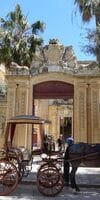Mdina (Maltese name: L-Imdina, ancient Greek name: ΜελτΤτη Melíttē, Arabic - مدينة, Italian - Medina) is a former fortified city on the island of Malta, which was the capital (from antiquity to the Middle Ages), and which today is one of the main tourist attractions of Malta.
Episodes of the famous TV series "Game of Thrones" were filmed in the city.
Approximately the city was founded by the Phoenicians in 700 BC, was called Maleth and later became part of the Roman Empire under the name Melite.
Mdina is located on the plateau of the top of the hill, where there was a fortified settlement already in the Bronze Age.
The city of Mdina is residential and is also known as the "Quiet City" (silent city), since the movement of cars is prohibited in Mdina (except for a limited number of residents, ambulances, wedding cars and horses); or the "City of aristocrats", since since the Middle Ages, it has been a city of aristocrats and religious authorities.
The city got its name from the Arabic word "medina" (city) - the old town, which is usually surrounded by a wall and has narrow, maze-like streets.
Today, as many years ago, the city of Mdina is surrounded by a city wall (now restored) with bastions and several gates.
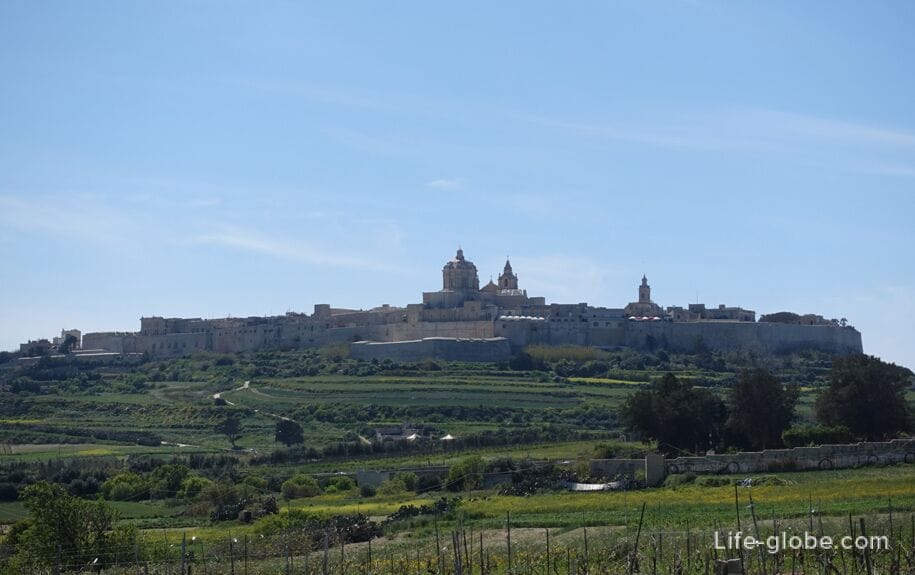
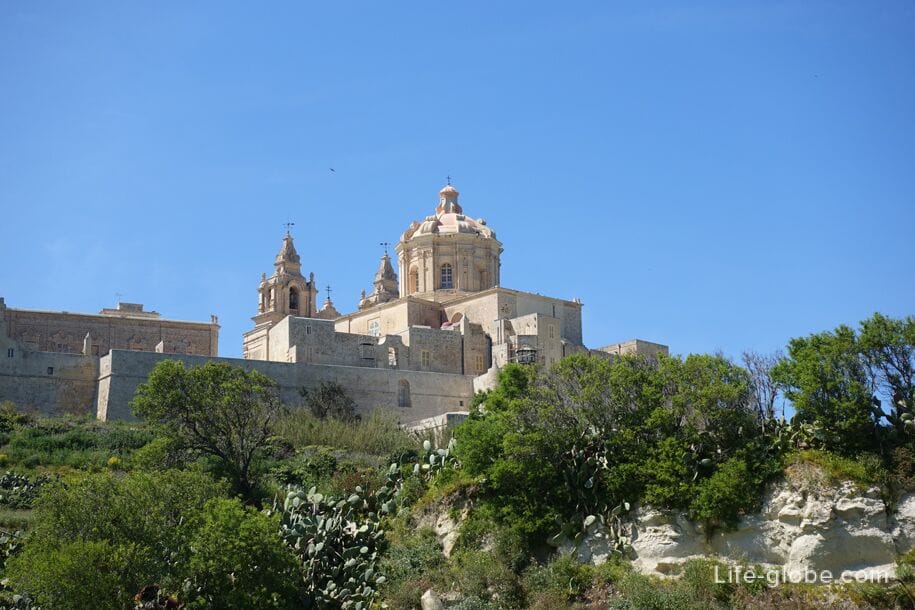
The city is an unusual combination of Norman and Baroque architecture, includes narrow streets and alleys with dense buildings, small squares, as well as palaces, some of which serve as private houses, churches, monasteries, a cathedral, and museums.
Also within the city there are shops and souvenir shops, cafes and restaurants, and some means of accommodation, for example: a 5-star hotel The Xara Palace Relais & Chateaux, 5 star hotel Palazzo Bifora, holiday home St. Agatha''s Bastion overlooking the sea, a sun terrace and a swimming pool, Guard Tower apartments, antique furnishings and are located in the tower with a terrace.
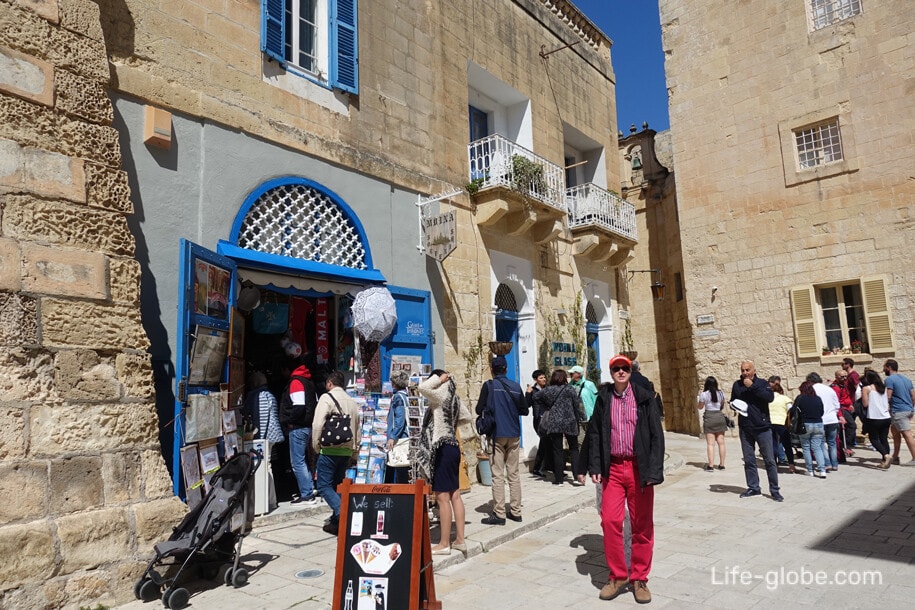
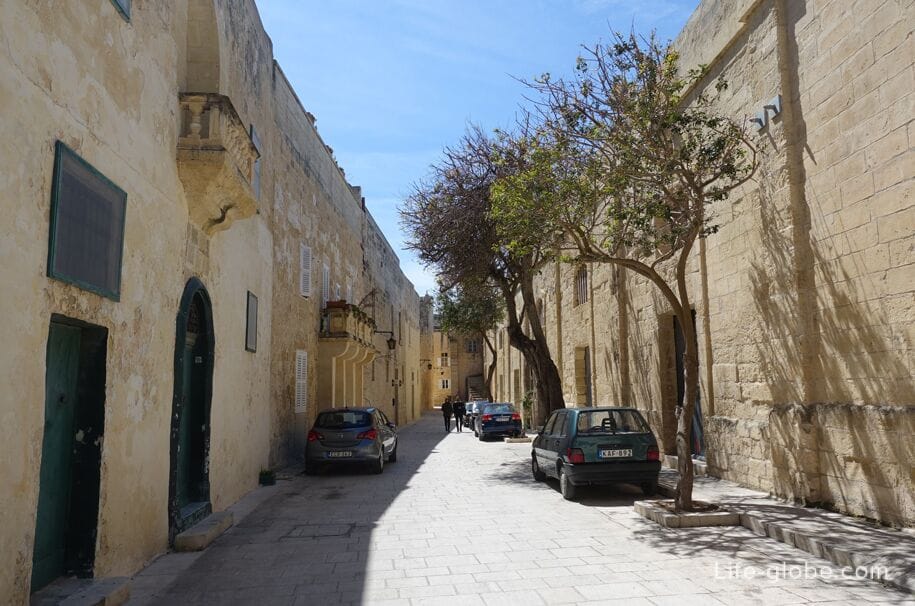
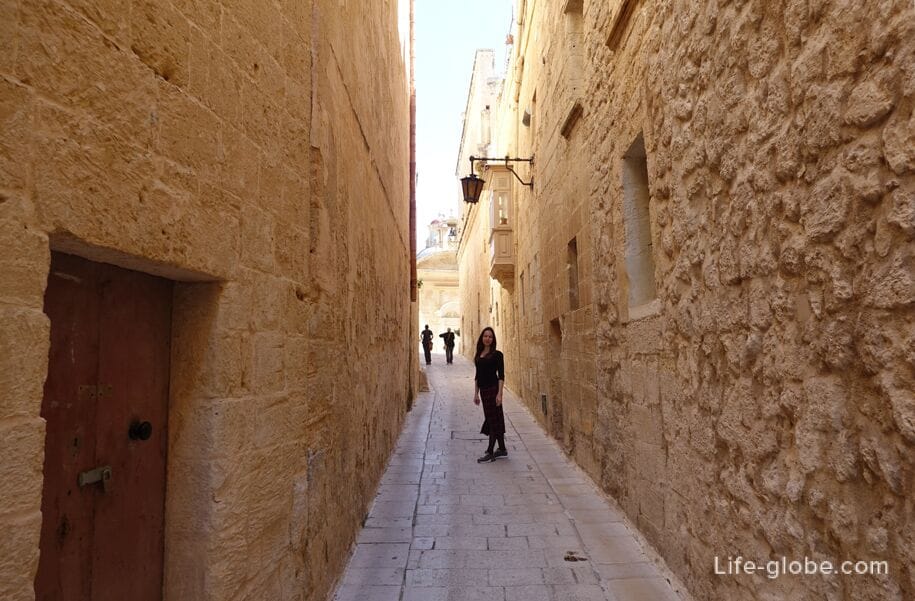
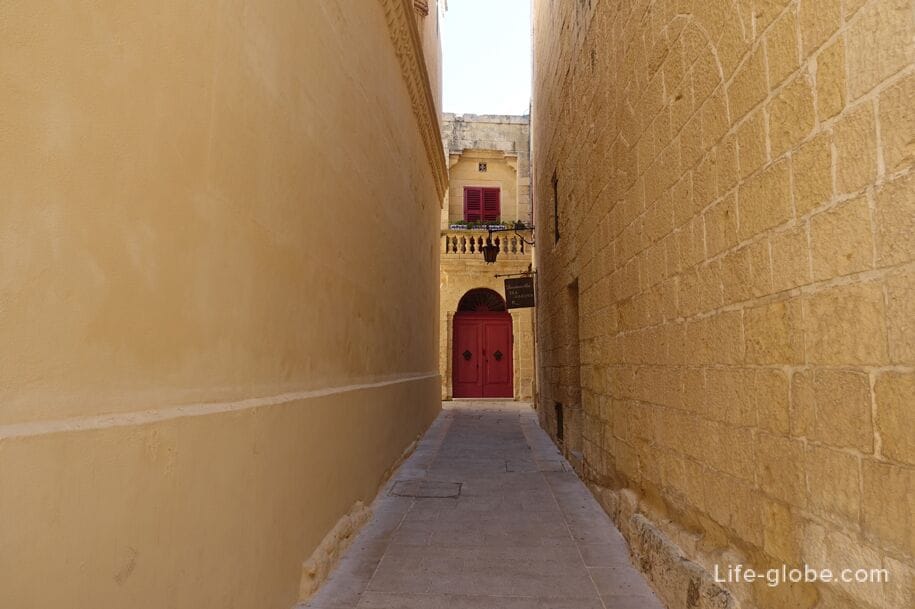
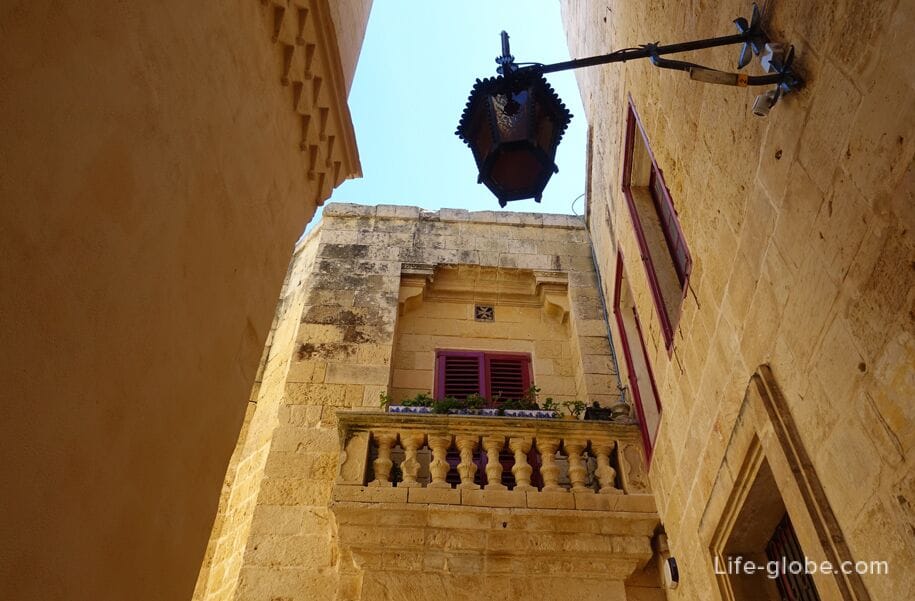
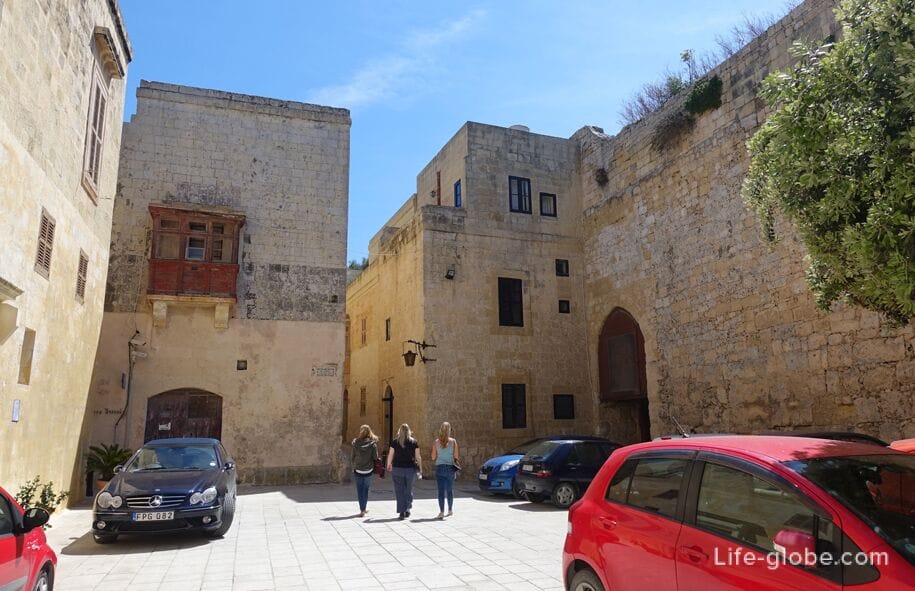

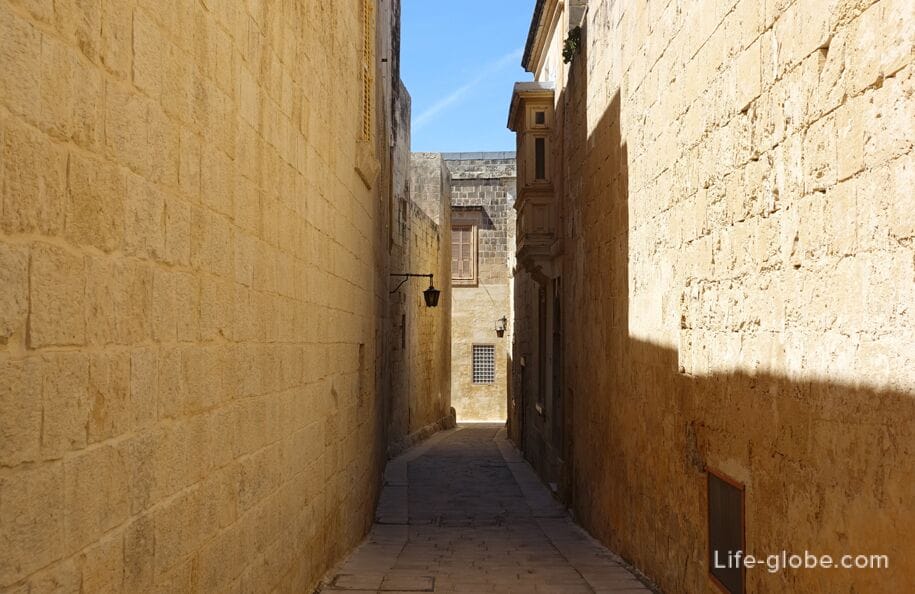
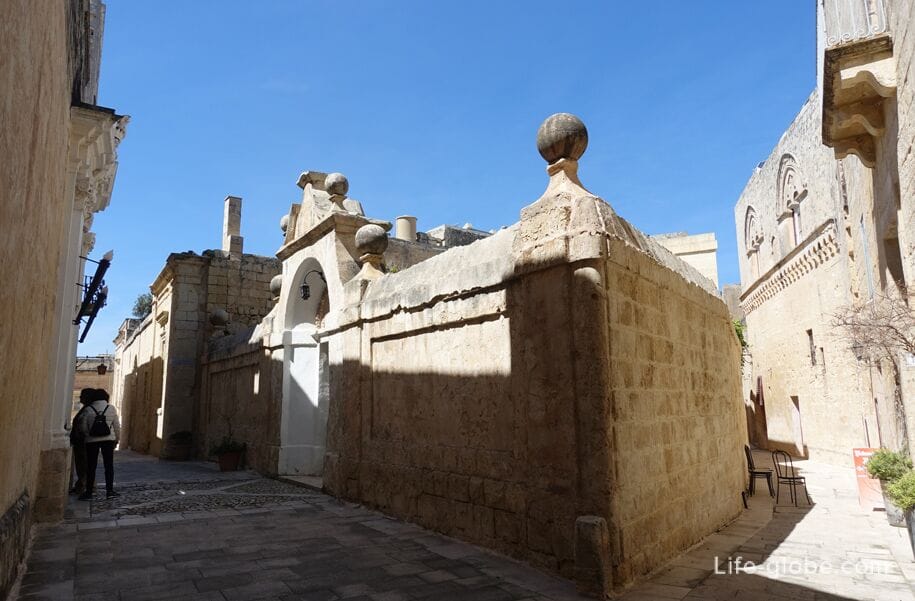

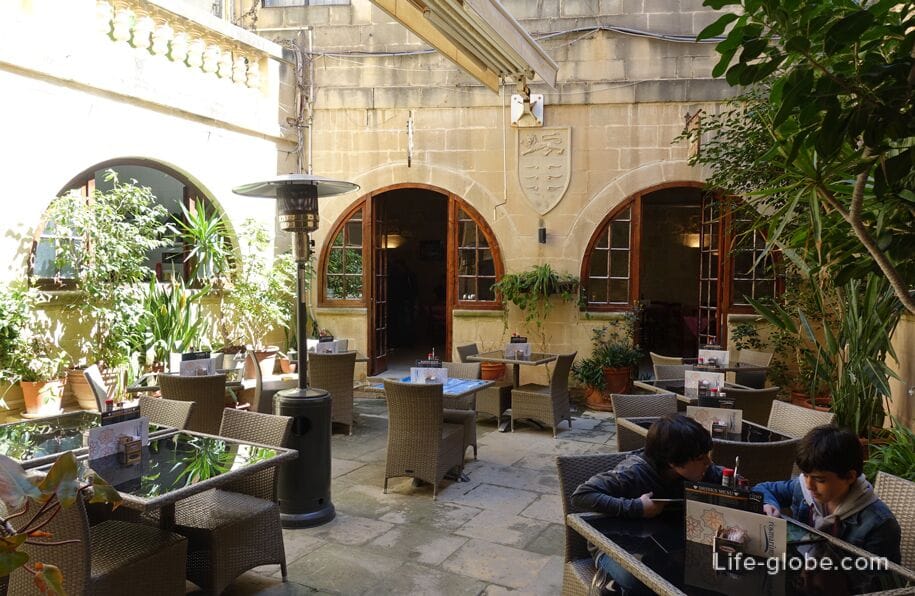

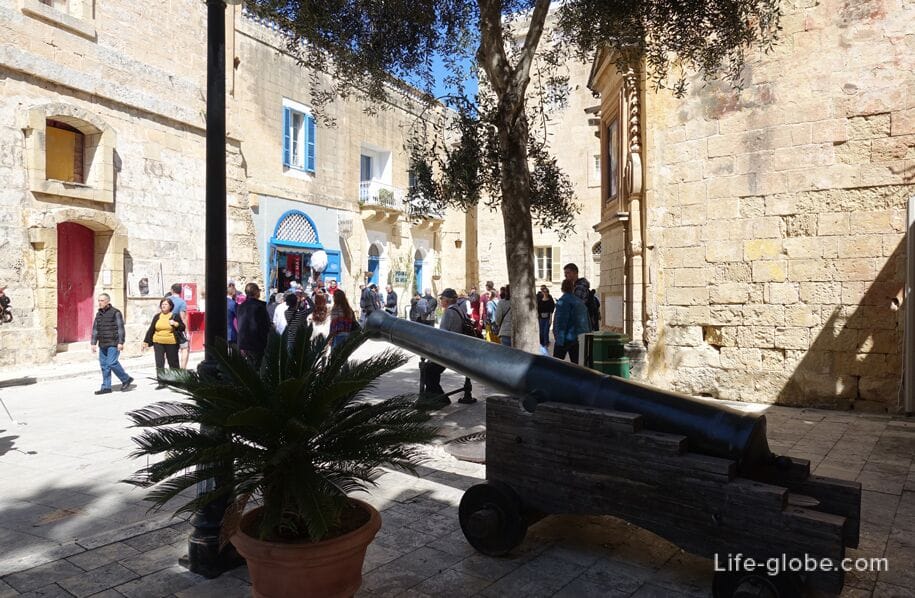

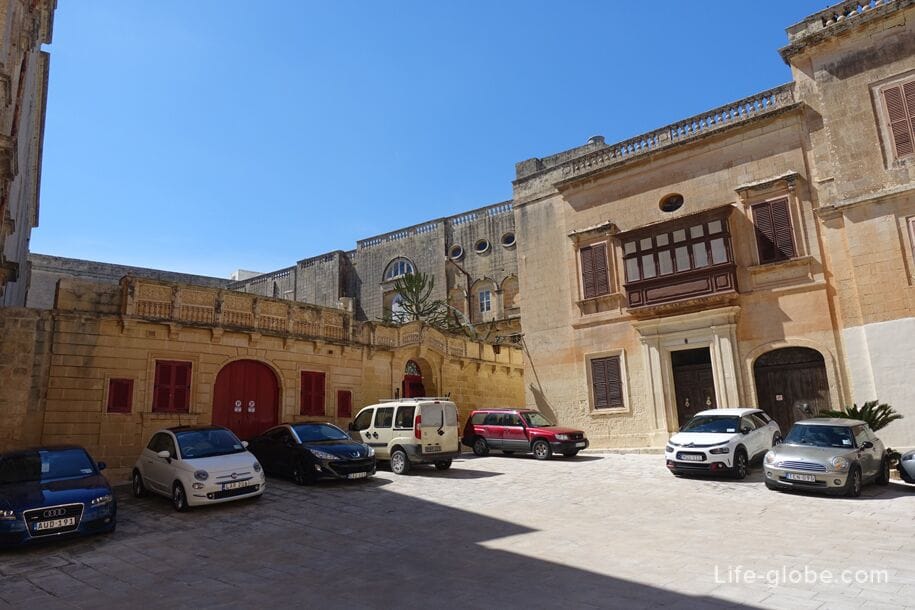
The central artery of Mdina is Villegaignon Street.
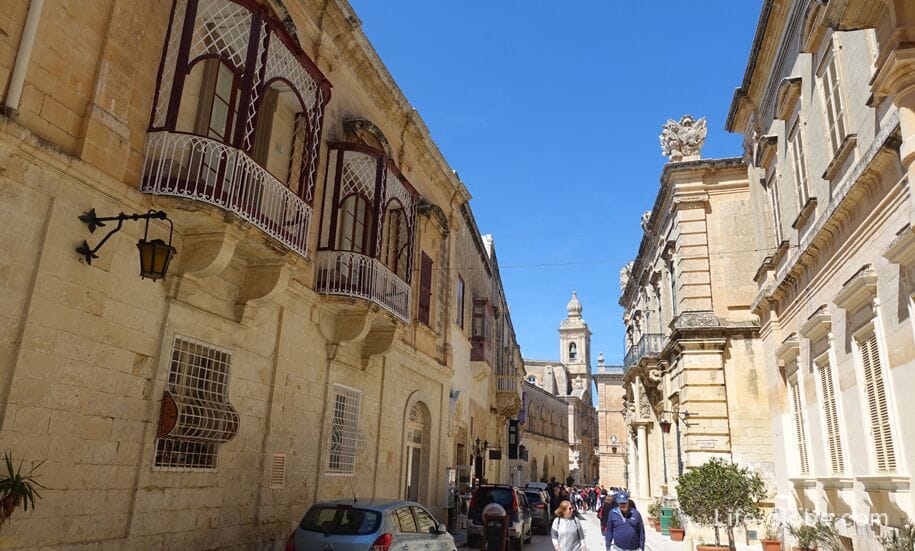
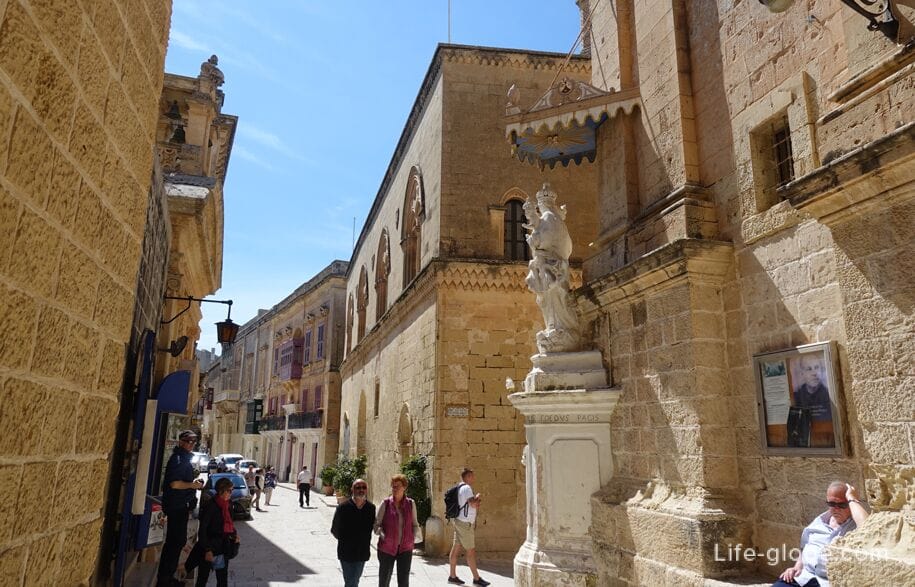
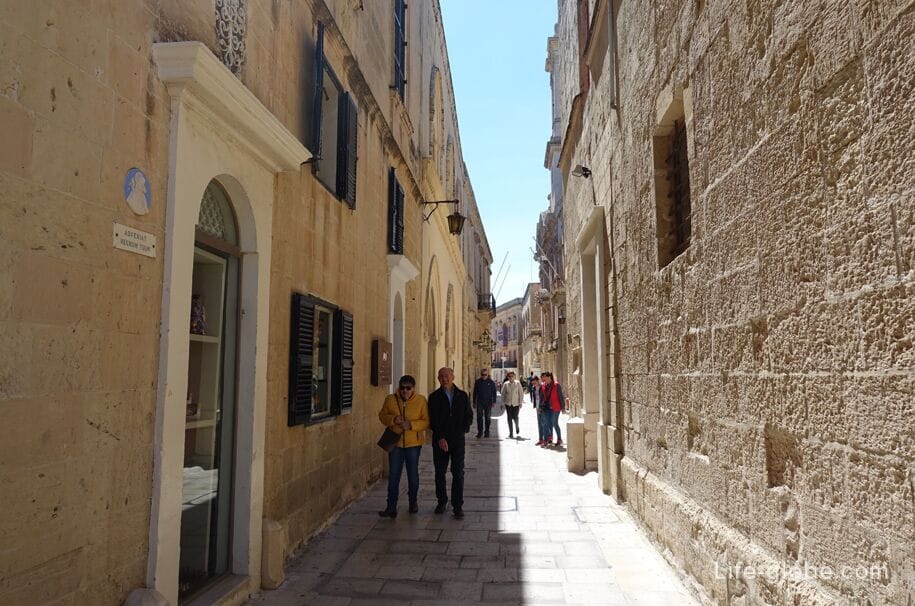
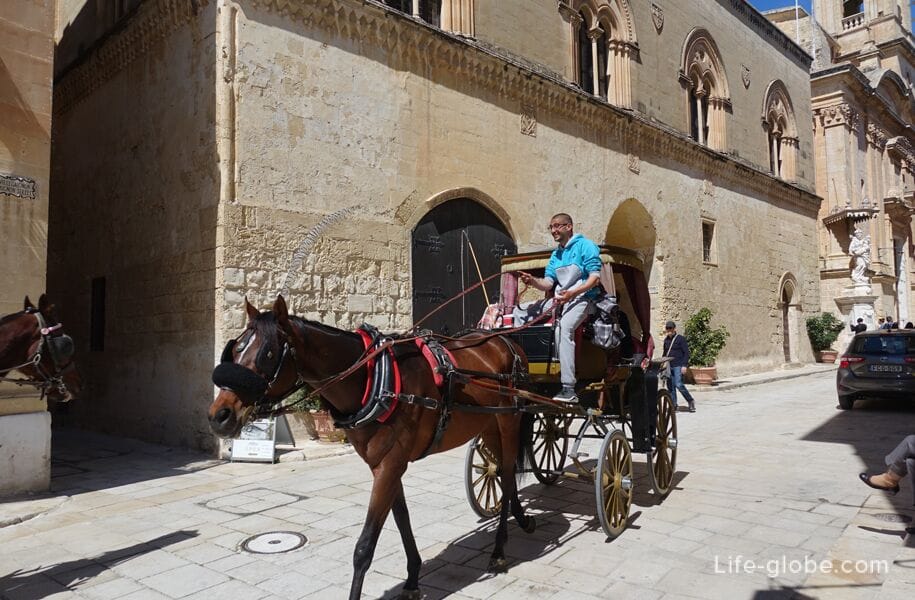
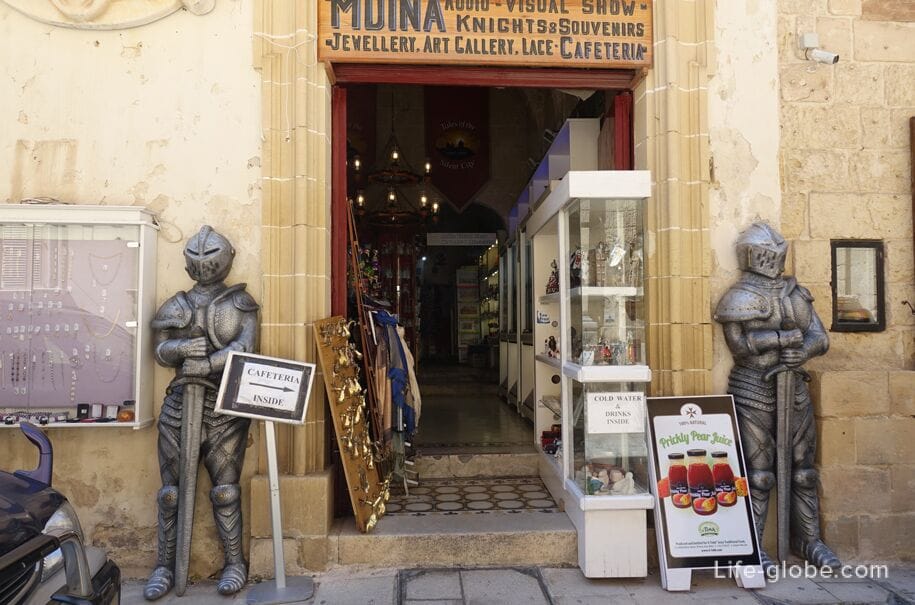
In addition to the walls, part of the city of Mdina is separated by a moat, which today has been turned into a park.
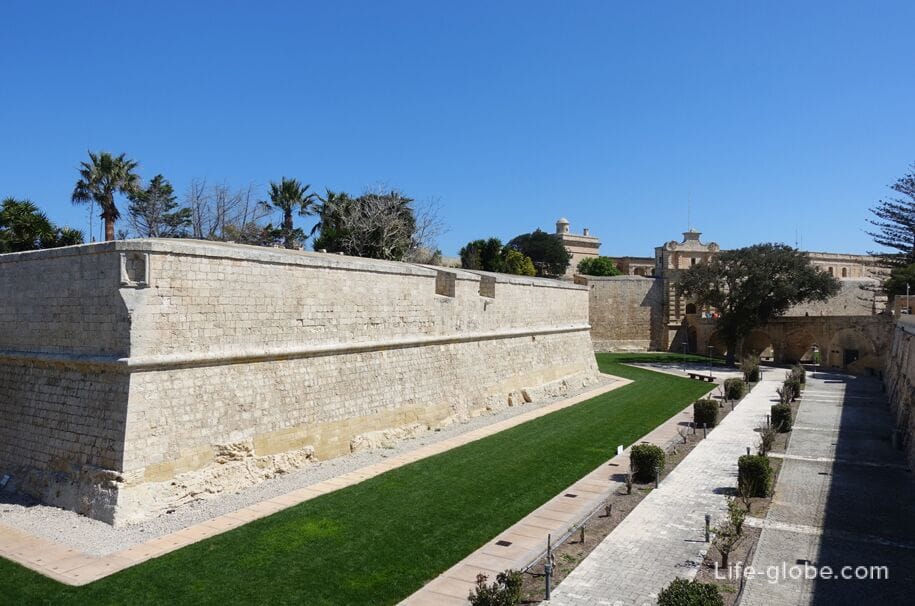

You can get to the city through the gates, the main of which is the St. Paul's Gate or simply the Mdina Gate (Maltese name: Il-Bieb tal-Imdina), built in the Baroque style in 1724 by Charles Francois de Mondion during the magistracy of Grand Master Antonio Manoel de Villena.
These gates were presented as one of the gates of King's Landing in the filming of "Lord Snow", the third episode of the first season of Game of Thrones.
A stone arched bridge decorated with statues of lions with the coat of arms of Vilhena, the neighboring city of Rabat, leads to the gate, across the moat. Initially, the bridge was connected to the gate by a wooden drawbridge a la Vauban.
The gate consists of an arched portal and a superstructure that served as a gatehouse. The gates are decorated with double pilasters, the coats of arms of Grand Master Antonio Manoel de Villena and the city of Mdina, a trophy and an inscription in Latin.

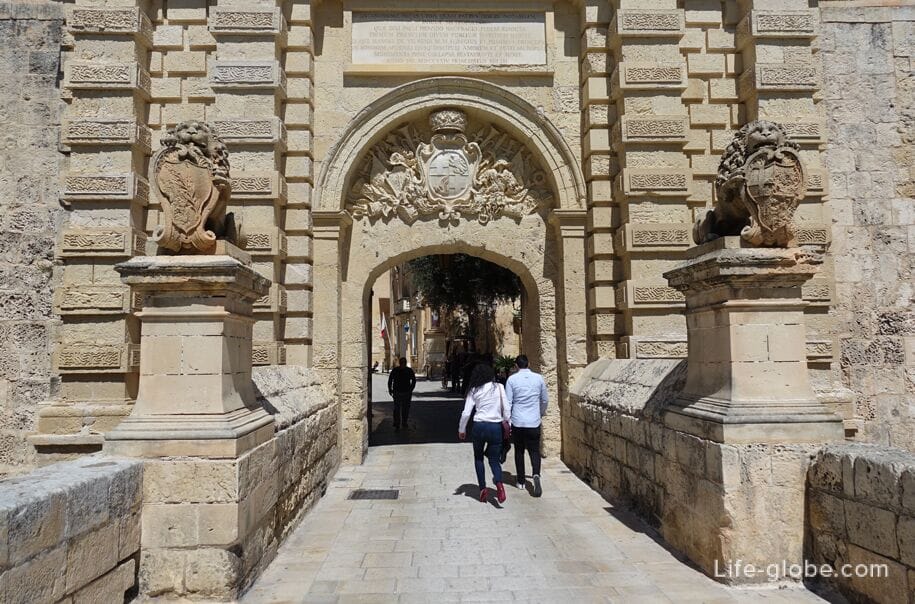
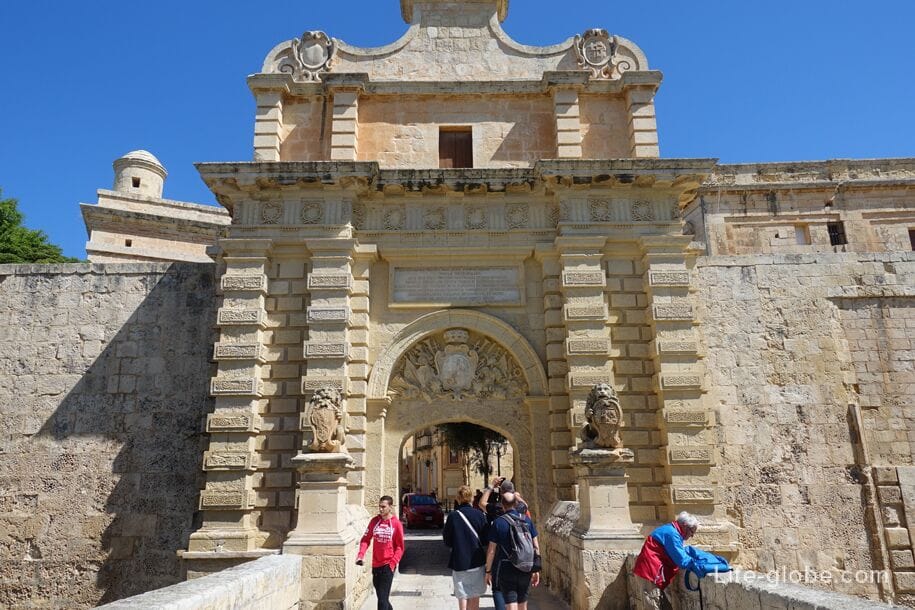
On the side of the city above the arch of the gate there are bas-reliefs of the patrons of Malta - Saints Paul, Publius and Agatha.

They also lead to the cityThe Greek Gate (Greeks Gate, Maltese name: Bieb il-Griegi or Il-Mina tal-Griegi) and there is also an arch with a ramp in the western wall, made specifically for the train, since in 1883 the British built a railway between Valletta and Mdina, along which trains ran until 1931.
The Greek Gate, located near the southwest corner of the city wall, was originally built in the Middle Ages, and its outer portal was built in the Baroque style in 1724 by Charles Francois de Mondion.
The exterior of the gate consists of a Baroque portal decorated with various coats of arms and an inscription in Latin.

The rear part of the gate (from the city side) retains its original shape in the form of a pointed arch, which makes it one of the few visible remnants of the medieval walls of Mdina.
The gate contains a fresco with an oil painting.

Behind the Main Gate of Mdina, behind the fence on the square of Valena (Palazz Vilhena) is the famous Palace of Valena or Vallena (Vilhena Palace, Maltese name: Il-Palazz De Vilhena), also known as the Palace of Magistracy (Palazz Maisterjali) or the Palace of Pretorio (Palazzo Pretorio).
The palace is made in the French Baroque style; named after Antonio Manoel de Villena, the Grand Master who commissioned it. The palace was built between 1726 and 1728 by the French architect Charles Francois de Mondion.
In the 19th and 20th centuries, the palace was used as a hospital, and after 1909 it became known as Connacht Hospital. Since 1973, it has been open to the public as the National Museum of Natural History of Malta.
The museum's collections include samples of flora and fauna, fossils, rocks, minerals and dioramas of Maltese habitats.
The palace has a U-shaped front yard surrounded by loggias (wings). Passage to the palace square is possible through the gate decorated with the coat of arms of Vilena. The central facade of the palace contains an ornate main doorway surrounded by Corinthian columns and topped with a bronze relief of De Villena and a coat of arms.
The interior of the palace has an irregular layout, sharply contrasting with the regularity and balance of the exterior. The building also has a courtyard.
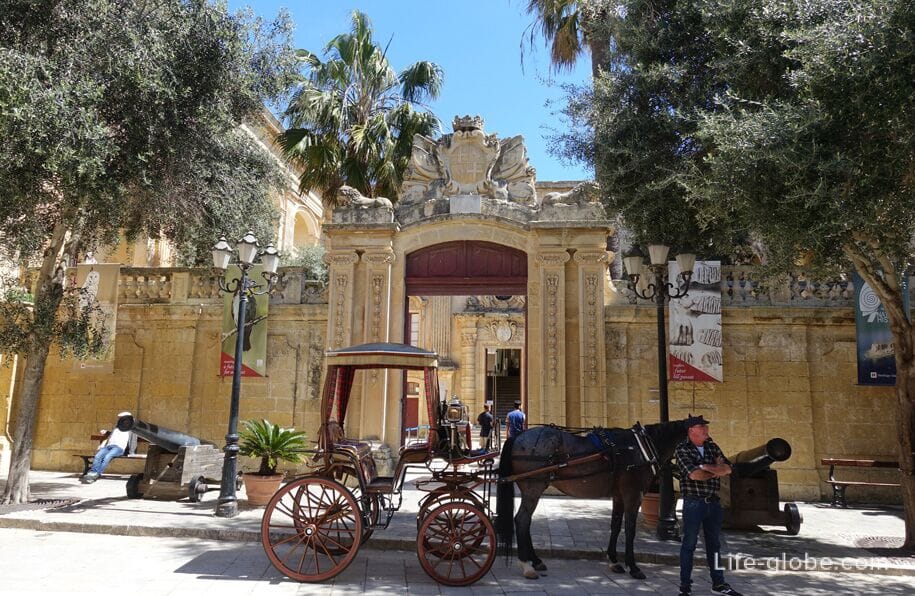
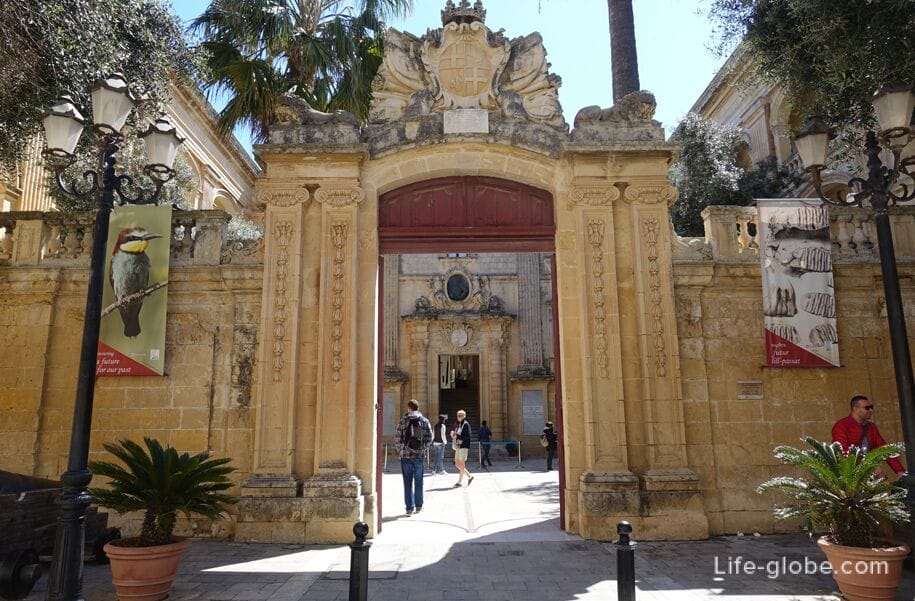
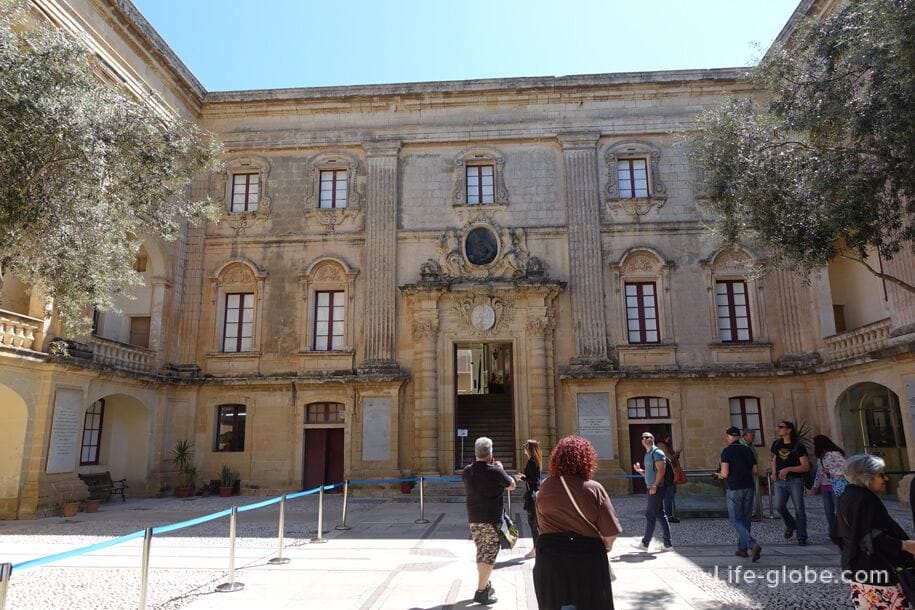

The Maltacom building (now Mdina Police) adjoins one of the wings of the palace.
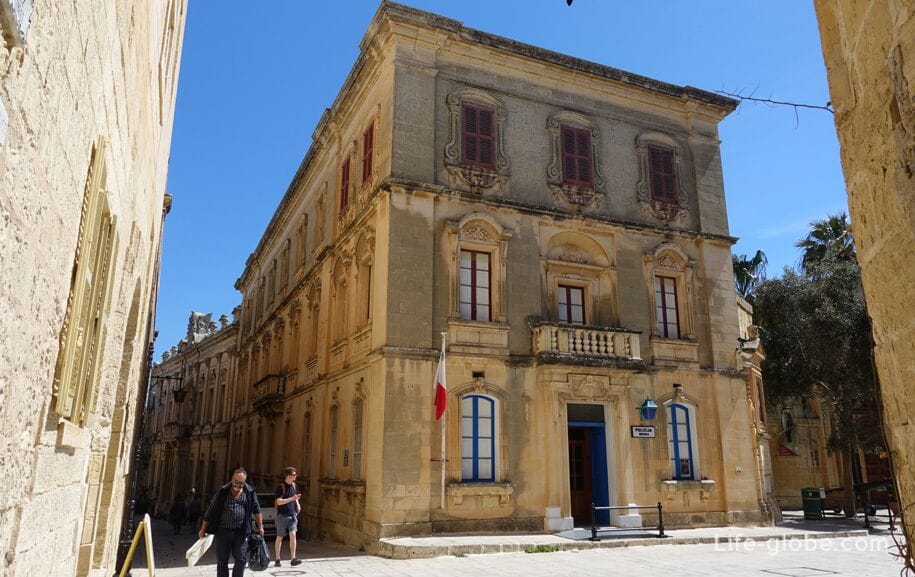
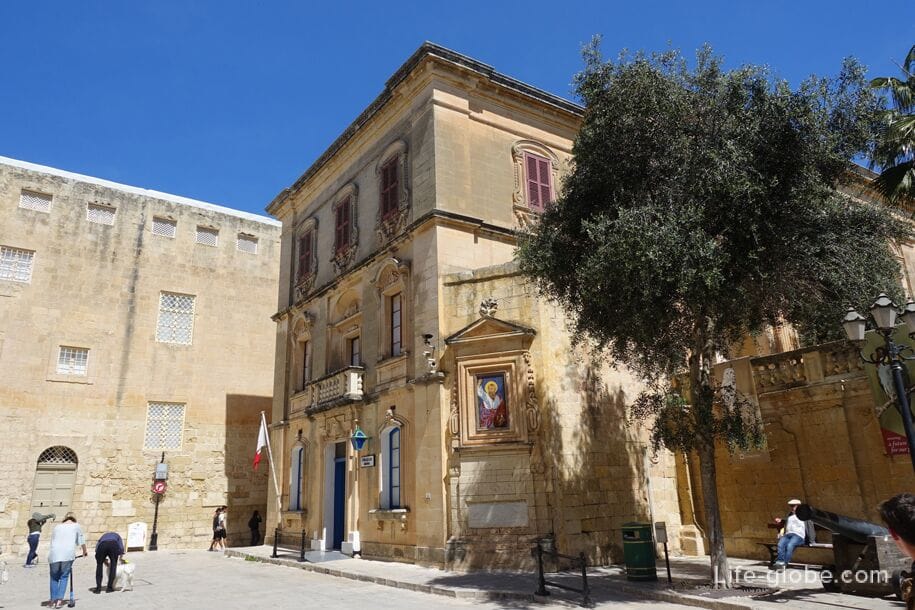
Opposite the Valena Palace stands the Tower of the Standard (Torre dello Standardo, Maltese name: It-Torri tal-Istandard), which was an integral part of the internal fortifications of the city and was built by the Order of St. John between 1725 and 1726 on the site of an earlier tower Torre Mastra, which was severely damaged during the earthquake on Sicily in 1693.
The purpose of the tower was to transmit signals between Mdina and the rest of Malta.
Today, the tower is in good condition and serves as a tourist information center and for periodic cultural events.
The tower has decorative elements in the Baroque style, such as stucco molding, as well as coat of arms shields with the coats of arms of De Villena and the city of Mdina.
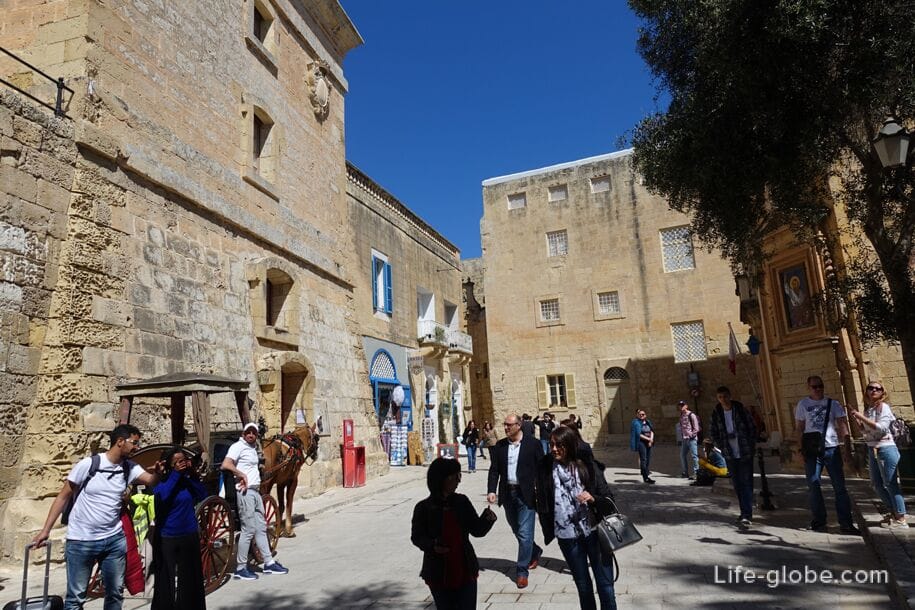
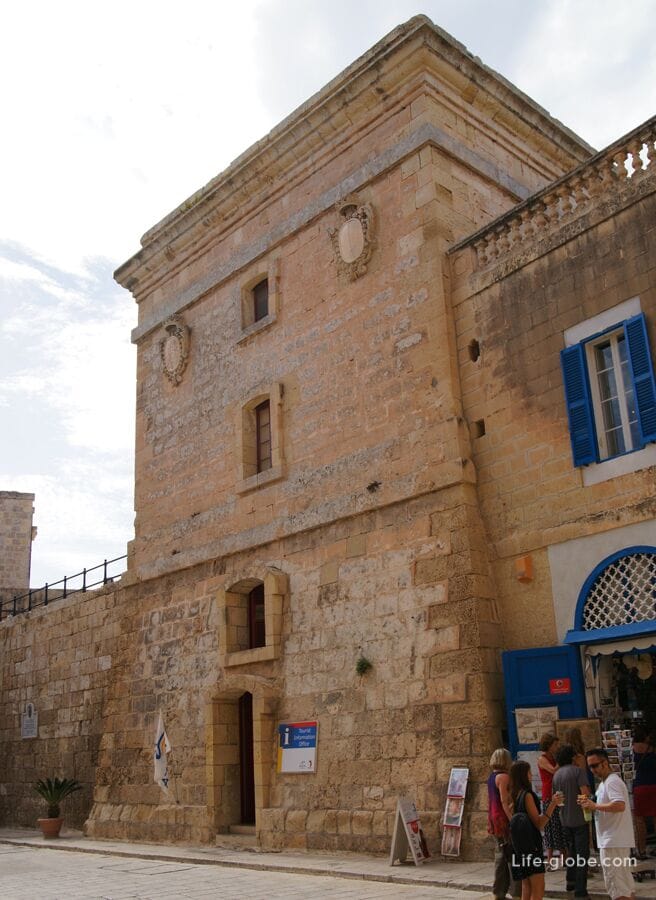
Adjacent to the Valena Palace, on the side of the Mdina Police Building, is the former courthouse Corte Capitanale (City Hall), which was the official residence of the Grand Master in Mdina, and currently serves as the town hall.
The building was built in the Baroque style between 1726 and 1728 by the French architect Charles Francois de Mondion. Although the building is connected to the Palazzo Villena, it has a separate entrance and facade.
The connection of the building with the palace was a symbolic gesture to emphasize the fact that the courts are under the jurisdiction of the Order of St. John. The courthouse was also connected to the Bishop's Palace via a now-blocked underpass, indicating the church's role in the courts.
The facade of the building is decorated with superimposed Tuscan and Corinthian pilasters and a cornice at the roof level. Above the main entrance there is a balcony decorated with allegorical statues of Justice and Mercy. The inscription "Legibus et Armis" (using laws and weapons) is inscribed under the central part of the facade.
The courthouse has several prison cells and dungeons built in the 16th century. The building is also connected to a loggia known asThe Loggia of the Herald (Herald's Loggia), from which the town criers announced decrees to people. The loggia predates the courthouse and is believed to date from the 17th century.
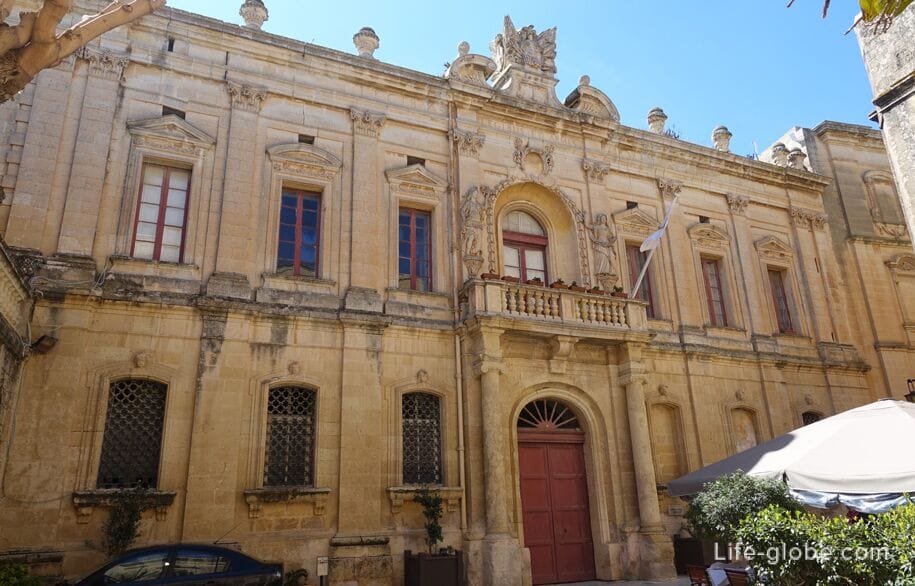
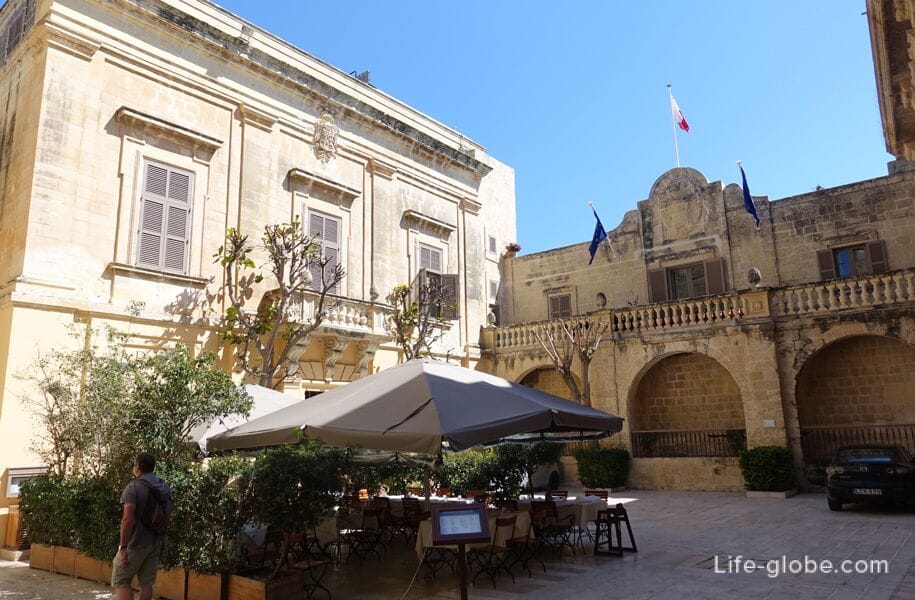
The small Chapel of St. Agatha, which is a Catholic church, dates back to the 17th century and was built on the site of a medieval shrine erected in 1417.

The main shrine of Mdina is The Cathedral of St. Paul or simply the Cathedral of Mdina (Maltese name: Il-Katidral Metropolitan ta' San Pawl) is a Roman Catholic cathedral dedicated to the Apostle St. Paul.
The cathedral was founded in the 12th century and traditionally stands on the spot where the Roman governor Publius met St. Paul after his shipwreck in Malta. The original cathedral was seriously damaged during the earthquake in Sicily in 1693, so it was dismantled and rebuilt in the Baroque style by the Maltese architect Lorenzo Gafa between 1696 and 1705. The cathedral is considered a masterpiece of Gafa.
According to tradition, originally on the site of the Cathedral of Mdina there was a palace belonging to Saint Publius, the Roman ruler of Melita.
St. Paul's Cathedral is built in the Baroque style with elements of local Maltese architecture. The main facade of the cathedral faces St. Paul's Square (Pjazza San Pawl or misraħ San Pawl). The cathedral is set on a low terrace, which is reached by three steps. The facade is divided into three parts by pilasters. The central part of the facade projects a little forward, and in it is the main entrance, crowned with the coats of arms of the city of Mdina, Grand Master Ramon Perellos y Roccafula and the Bishop. The current archbishop's colored coat of arms is located just below the coat of arms of Mdina. In the upper tier, above the doorway, there is a window, and the facade is completed by a triangular pediment with a cross. On both corners of the facade there are bell towers, originally accommodating six bells. The cathedral also has an octagonal dome.
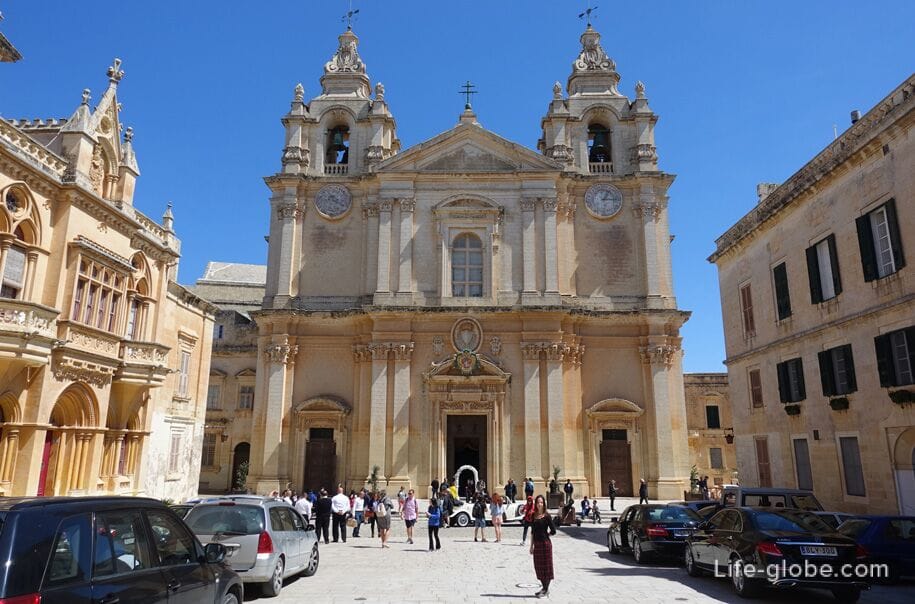
Inside, the cathedral has a Latin cross plan and is divided into three naves with main and side altars.
Most of the cathedral's floor consists of inlaid tombstones or commemorative marble slabs. The remains of several bishops and canons, as well as laypeople from noble families, are buried in the cathedral.
The ceiling of the cathedral is decorated with frescoes depicting the life of St. Paul, which were originally painted by Sicilian artists Vincenzo, Antonio and Francesco Manno in 1794.






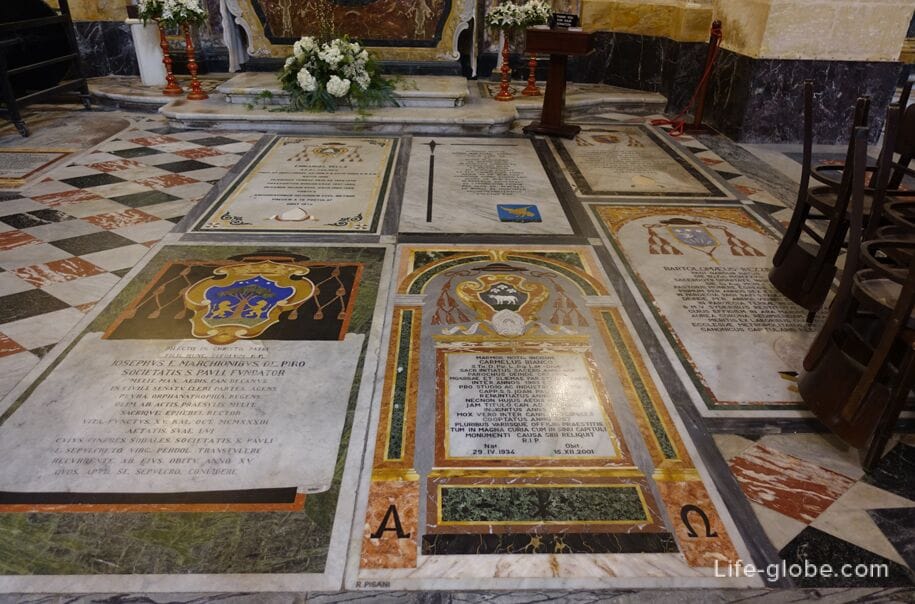

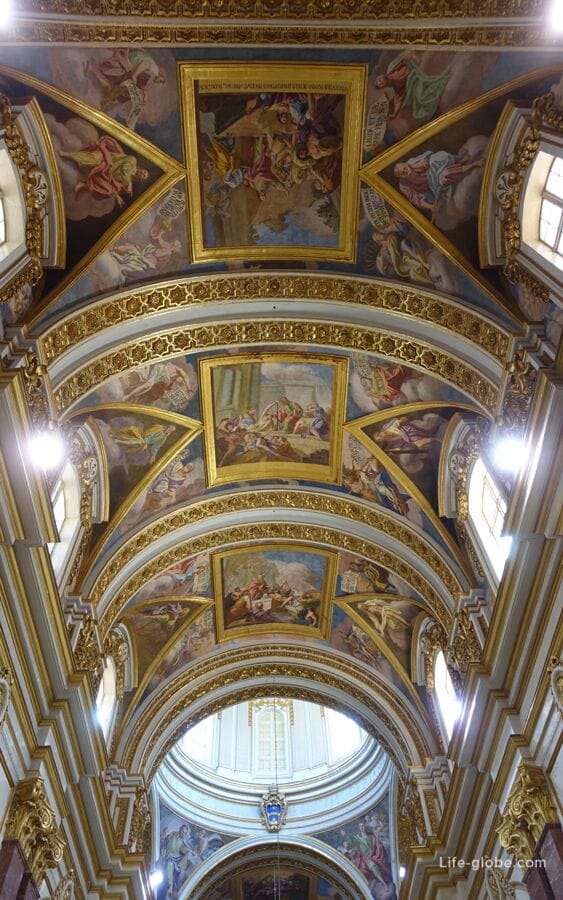
On the right side of the cathedral, on the Archbishop's Square (Pjazza tal-ArisIsqof or misra l l-ArċIsqof) is the building of the former seminary, which now houses the cathedral Museum, founded in 1897.
The seminary was built between 1733 and 1742 in the Baroque style.
The museum's collection includes an eclectic secular and ecclesiastical repertoire. This includes religious and secular works of art dating from the 14th to the beginning of the 20th century, including a number of medieval panels that were previously in the cathedral; a money gallery with a collection of antique coins; religious and household silver, religious vestments, historical furniture and the main collection of the museum - a permanent exhibition of original woodcuts by Albrecht Durer.
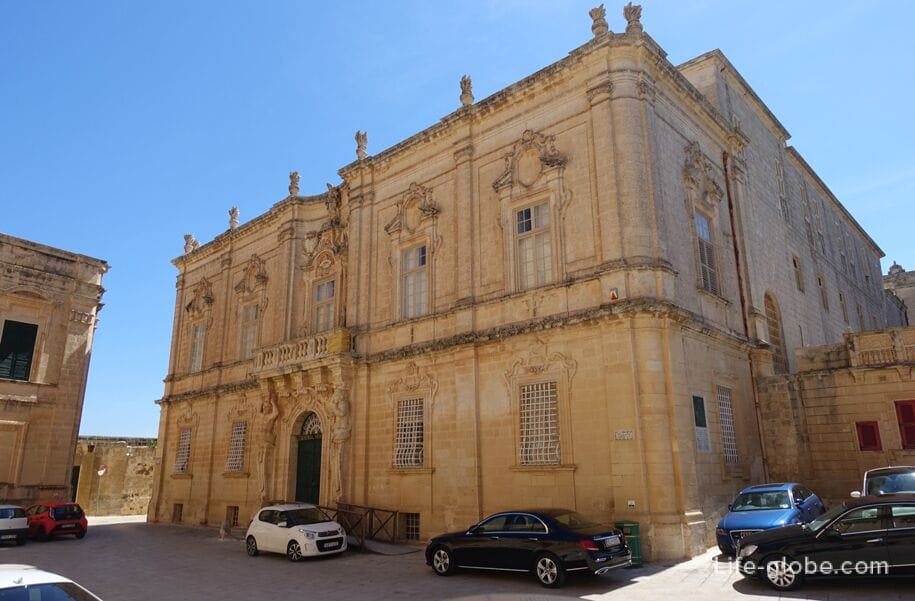
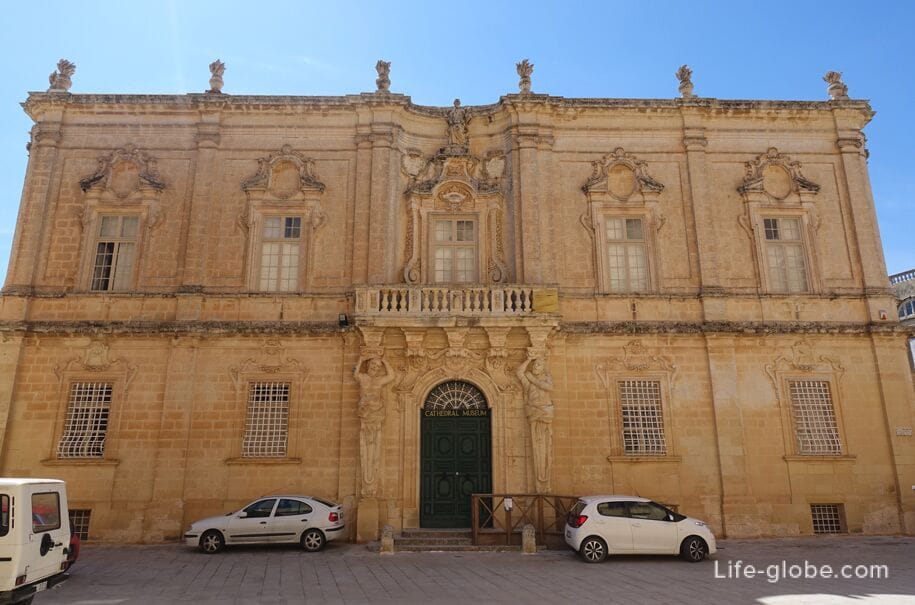
In addition to the cathedral, there are other significant buildings on St. Peter's Square, which, together with the cathedral, give the square solemnity and grandeur.
Especially noteworthy is the building made in the style of English Gothic - the Palace of Gourgion, which sharply contrasts with the simpler-designed neighboring buildings.
In the exterior of the Gurgion Palace, pointed arches, rosette windows, carved ornaments and the coat of arms of the Knights Hospitaller, the Sovereign Military Order of Malta, attract attention.
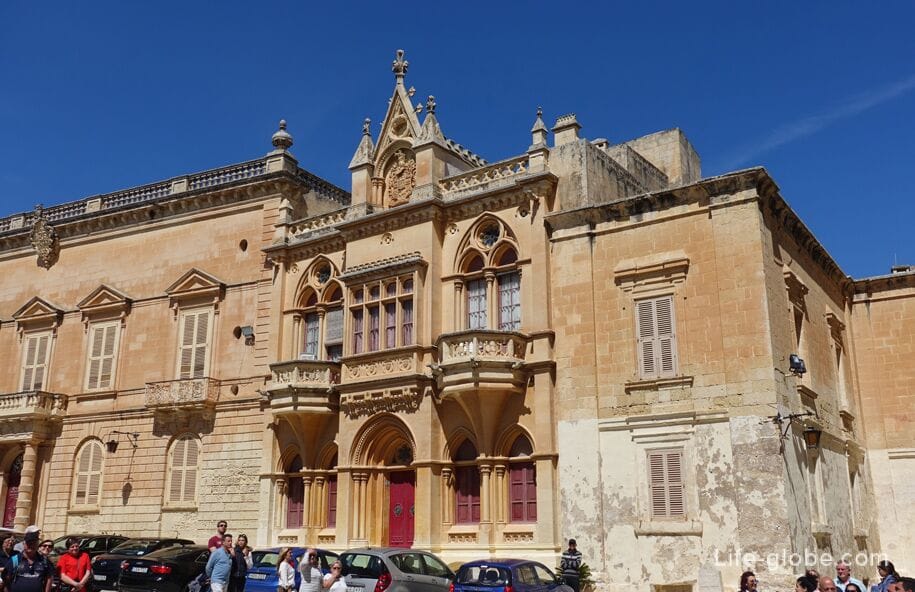
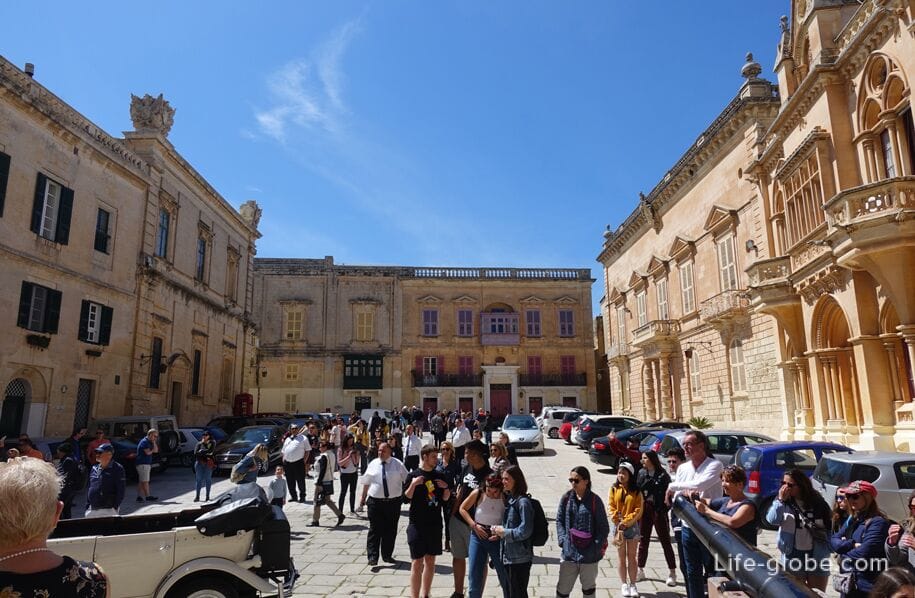
There is an exquisite building near St. Peter's SquareThe City Palace (Banca Giuratale, Maltese name: BankaurUratali), also known as the Municipal Palace (Municipal Palace, Maltese name: Palazz MuniċIpali).
The palace was built between 1726 and 1728 to house the city council and courts, and was later used as a private residence and school. It now houses part of the National Archives of Malta.
The building is made in the Baroque style. The main entrance has an ornate semicircular vault supported by two columns, above which there is a balcony.

The Testaferrata Palace (Casa Testaferrata) is adjacent to the city palace.
This is the palace of the local aristocratic family Testaferrata.
The building is distinguished by the main entrance with columns that support the balcony from which, as they say, the Maltese threw the French governor head down when a riot broke out against the Napoleonic troops.
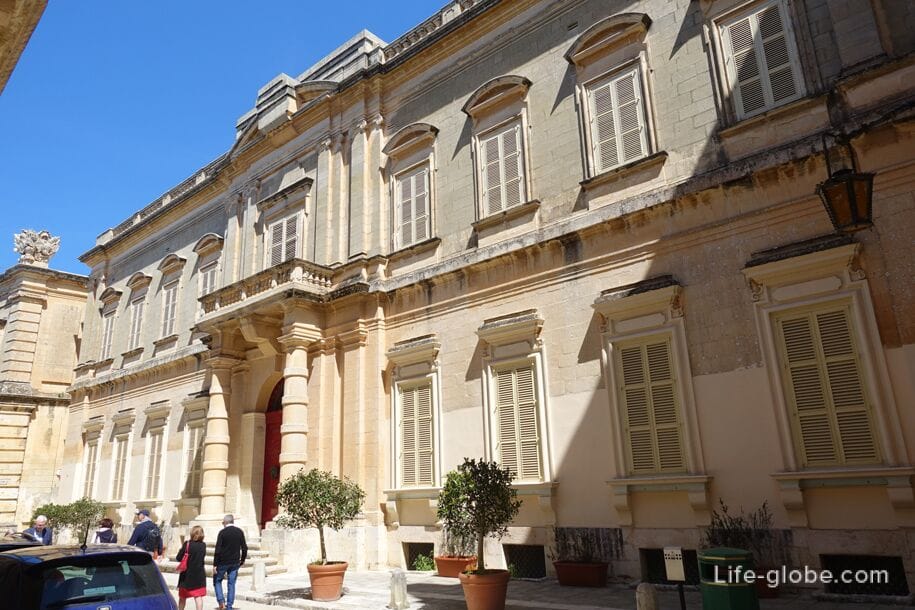
The Palazzo Santa Sofia, the first floor of which was built in 1233 and is considered the oldest surviving building in the city. The upper floor is a later building erected in the 20th century.
During its history, the building was periodically rented out and used as a school run by Roman Catholic nuns.
Today the palace is privately owned. The palace is not open to the general public, although it can be rented for dinner or cocktail parties, lectures or other events.
The facade of the first floor of the building is quite simple, it has two doors with a passage between them. A two-tier cornice separates the first floor from the second. The later upper floor is distinguished by four decorative multi-layered windows, and a single-tier cornice is located at the roof level. Several coats of arms can be seen on both floors of the facade of the building.
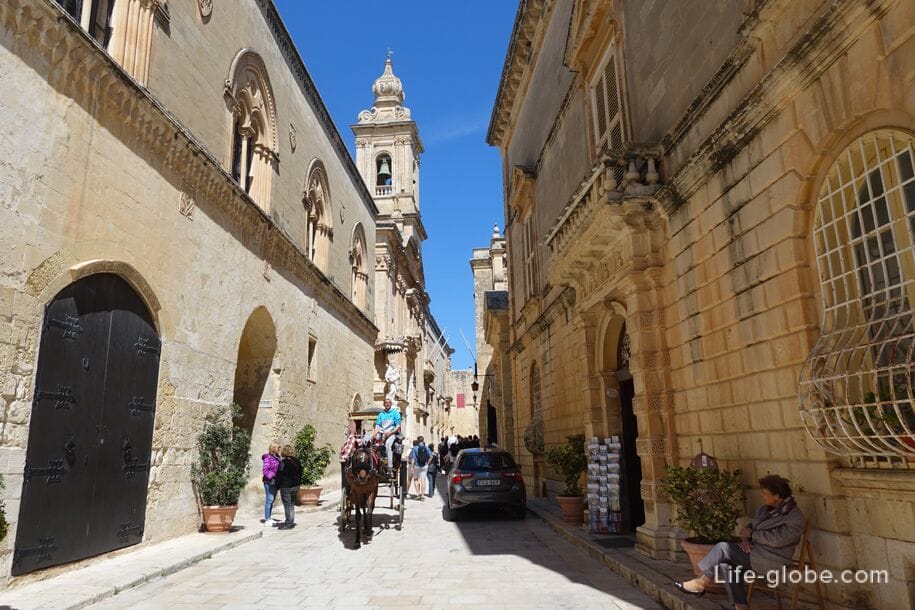
Near the Hagia Sophia Palace there is a monastery and a Baroque Carmelite Church (Carmelite Church And Priory), which attracts attention with a high bell tower and a sculpture at the outer corner of the building.
Historical records mention that another church dedicated to the Nativity of the Virgin stood on the site of the current church; other sources mention that the chapel was dedicated to the Virgin of the fortress (della Rocca).
The chapel and its surroundings were handed over to the Carmelites in the 1650s. The church was built between 1660 and 1675 by Mederico Blondel de Croisette. During the French occupation, the church was looted.
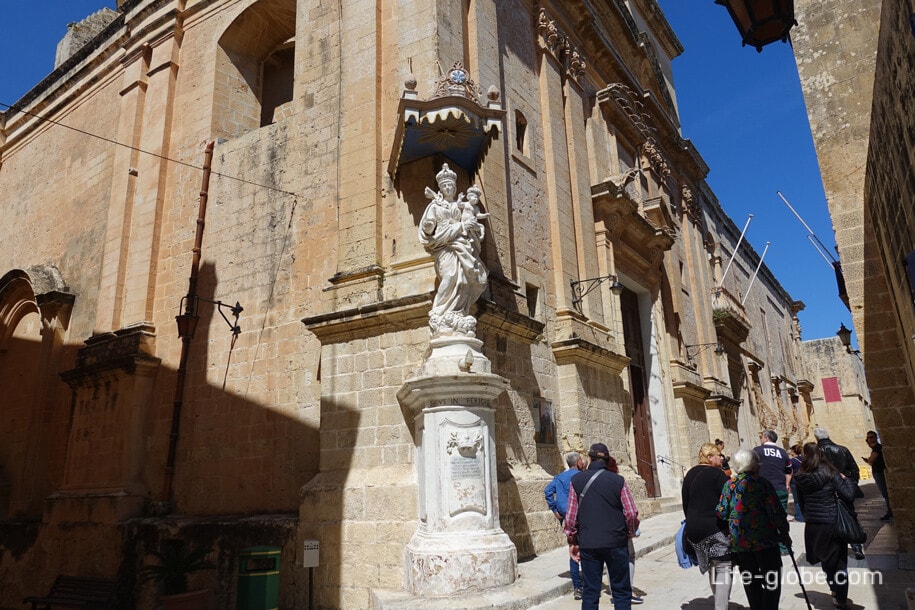
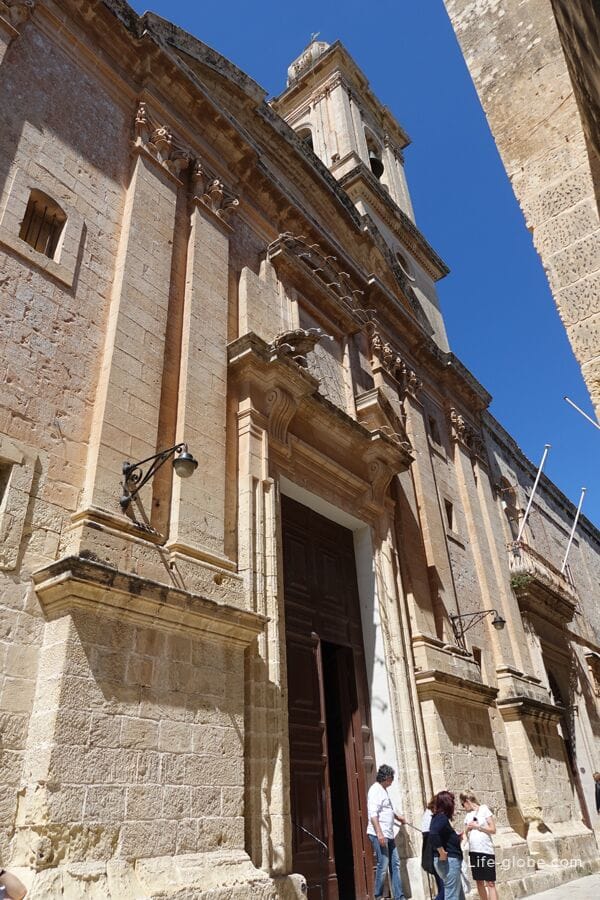
The interior of the church is decorated with Baroque sculptures and paintings by famous artists such as Mattia Preti, Stefano Erardi, Michele Bellanti and Giuseppe Cali. The richly carved and gilded wooden frame around the titular painting is the work of Pietro Paolo Troisi, and the statue of Our Lady on Mount Carmel is the work of Maltese sculptor Andrea Imbroll.

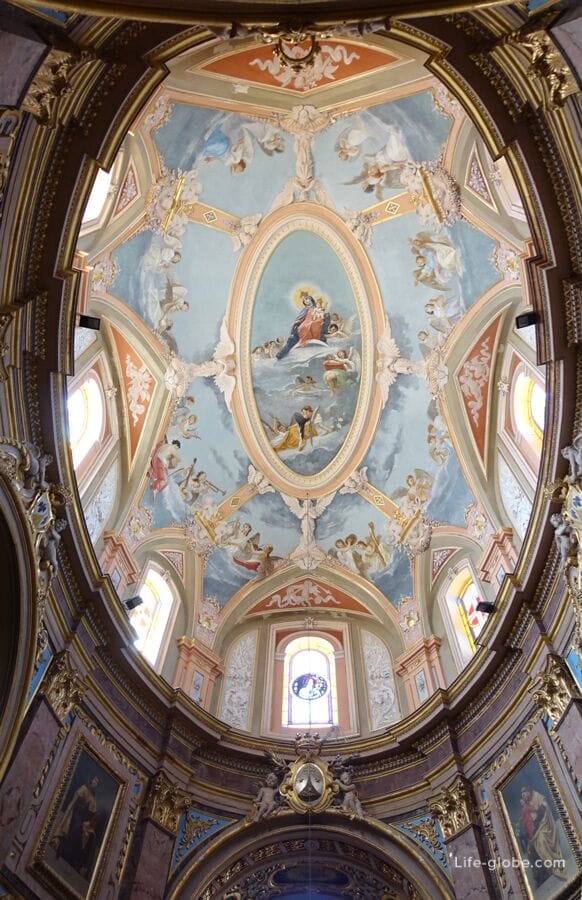
Opposite the Carmelite Church is the little Chapel of St. Roque (Chapel of St. Roque), also known as the Chapel of Our Lady of Light and is a Roman Catholic chapel.
The original chapel building, which stood on the site of the current church, existed in 1393. However, the chapel was demolished in 1681, and another dedicated to Saint-Roque was built in the 18th century. Over time, this chapel became known as Our Lady of Light, as a consequence after a painting depicting the Virgin of Light was installed in the chapel.
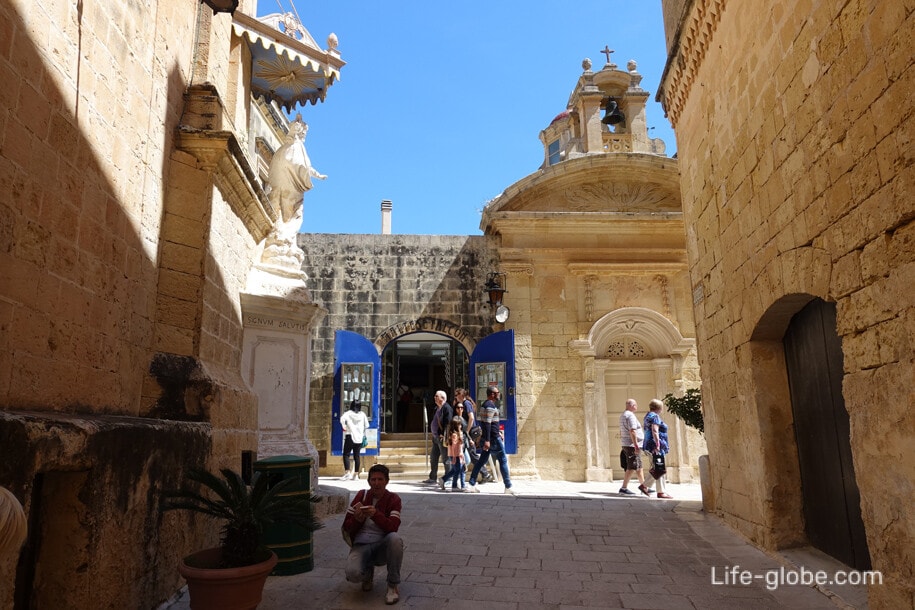

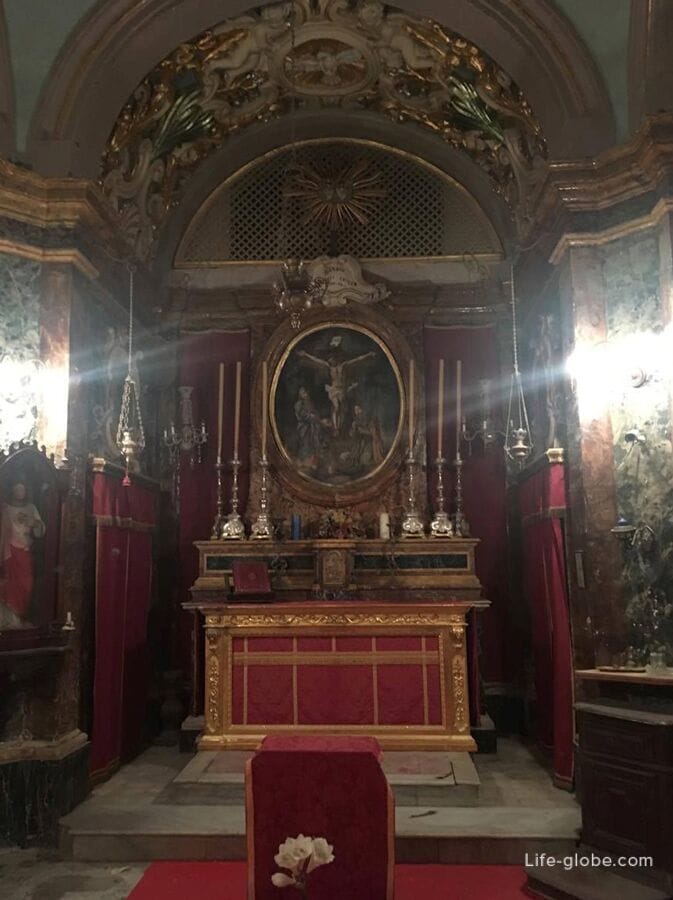
Constanzo Palace, which was previously the residence of a noble Sicilian family.
The palace was built in 1666 by Tomaso Costanzo. The building was later converted into a restaurant. There is also an exhibition "The Middle Ages", which introduces the local life of the 14th and 15th centuries.
The house has two floors and basements. The facade of the building is symmetrical and includes a rectangular doorway, above which there is a small oval window and an open balcony; two windows are also located on the sides of the door and balcony; and the cornices and frames of doors and windows are decorated with simple ornaments.
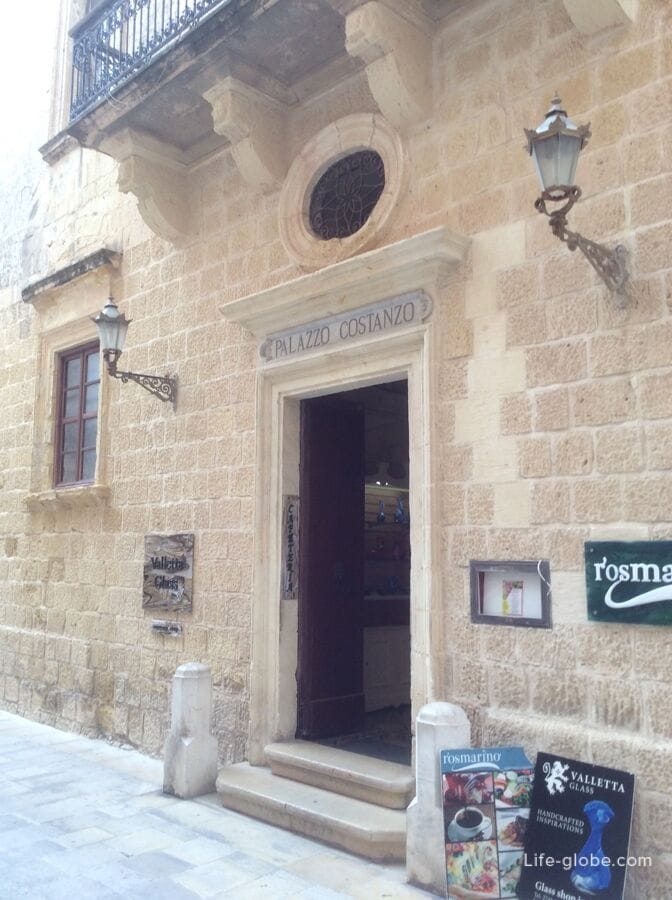
The Falson Palace, which is a medieval house originally built around 1495 as a family residence of the Maltese nobility and named after the Falson family.
Currently, the building is open to the public as a house museum with halls of historical household items and several antique collections. Temporary exhibitions are also held in the house.
The palace consists of two floors and is built around a central courtyard. The first floor is built in the so-called Maltese folk style and possibly includes part of an earlier structure. The second floor is decorated more richly and is separated from the first by a two-tier cornice. The facade has Spanish influences, with a number of Catalan-style windows. The single-tier cornice is at the roof level.

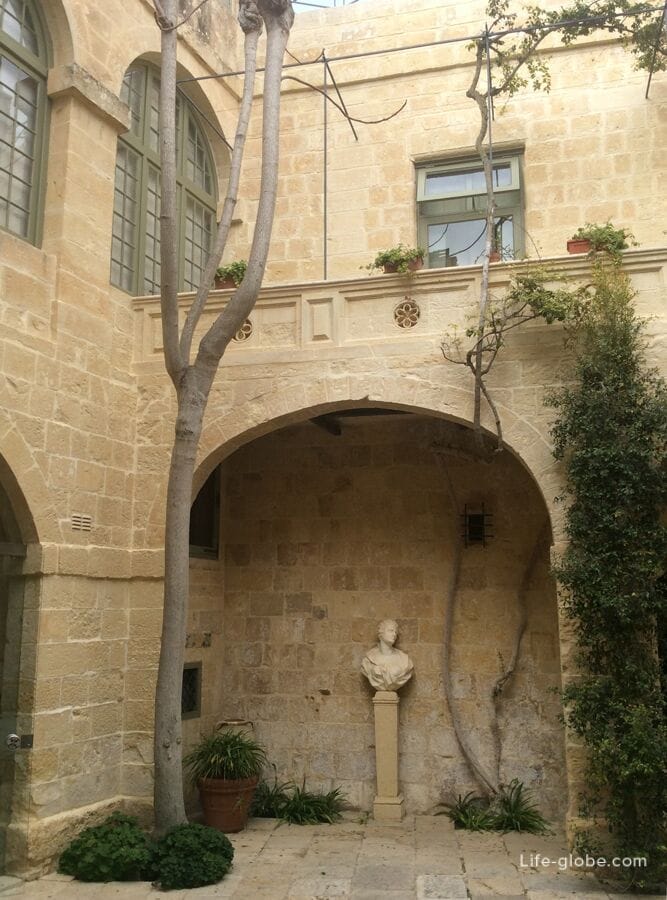
In the north-western part of Mdina, near the square, there is an exit to the observation deck of the city wall, which offers panoramic views of the island of Malta and the sea. The largest and most famous church of Malta is also visible - The Rotunda Mosta with a bomb museum, an observation deck and an underground shelter during the war.


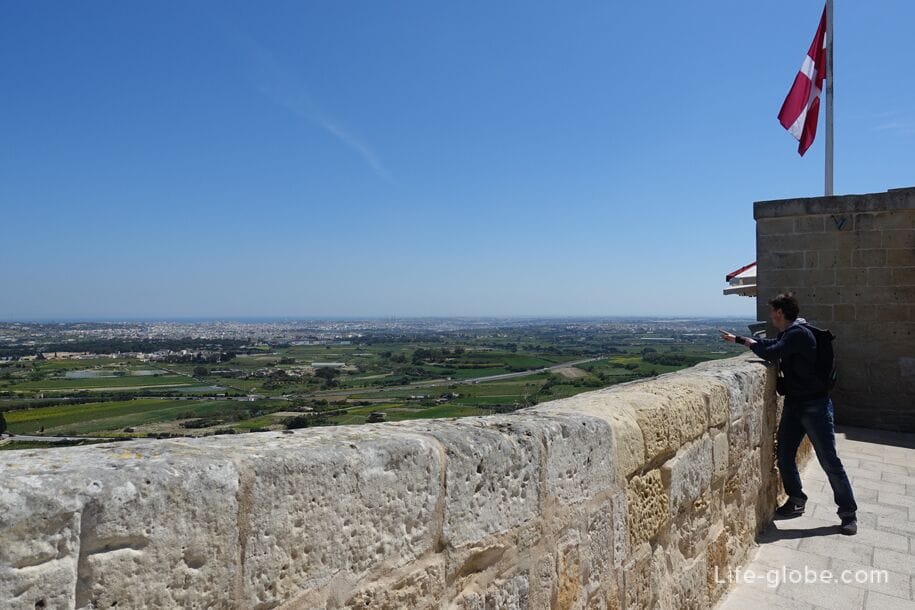
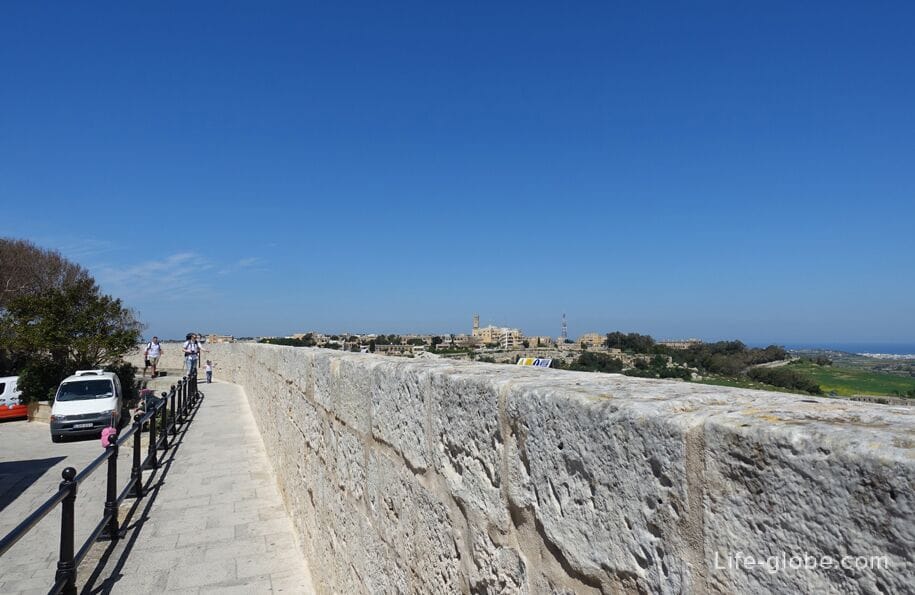
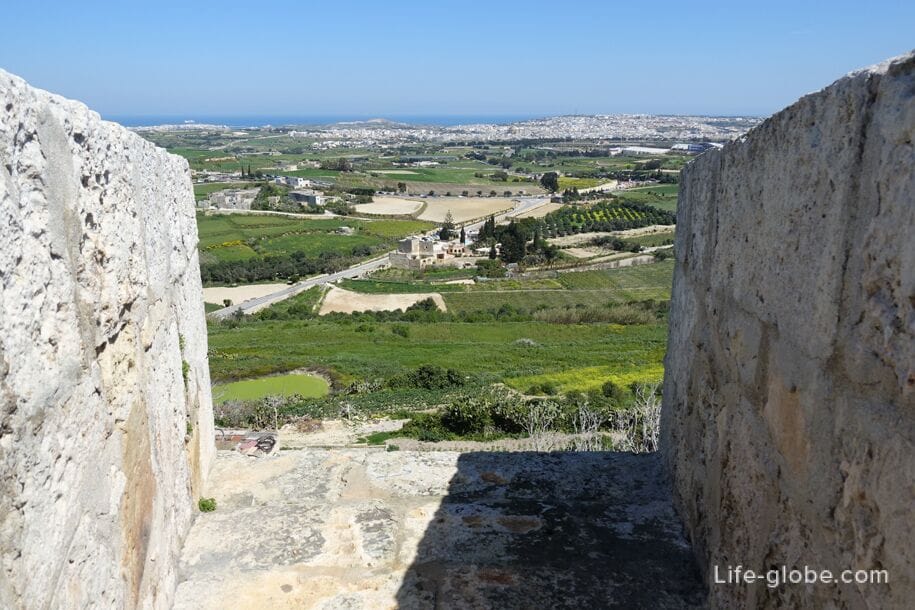
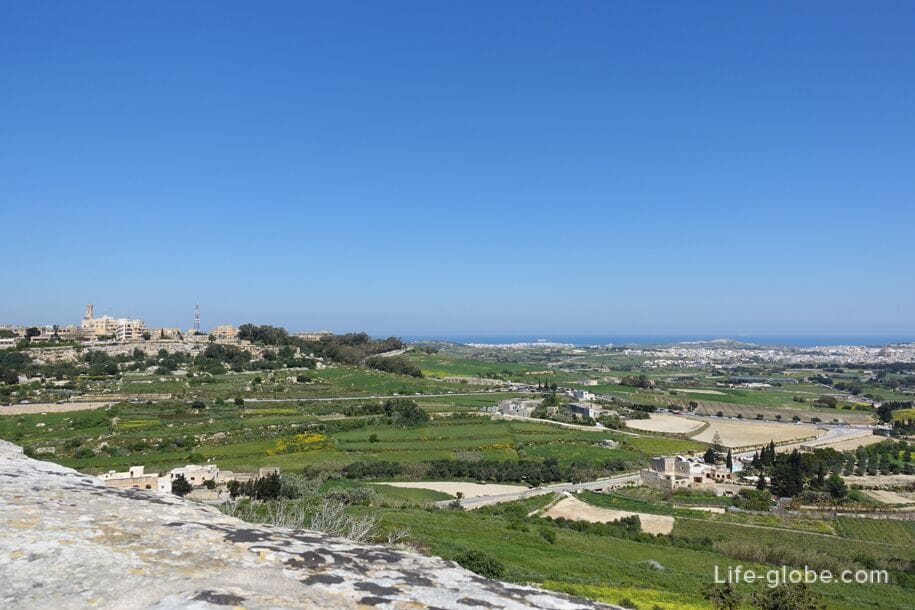
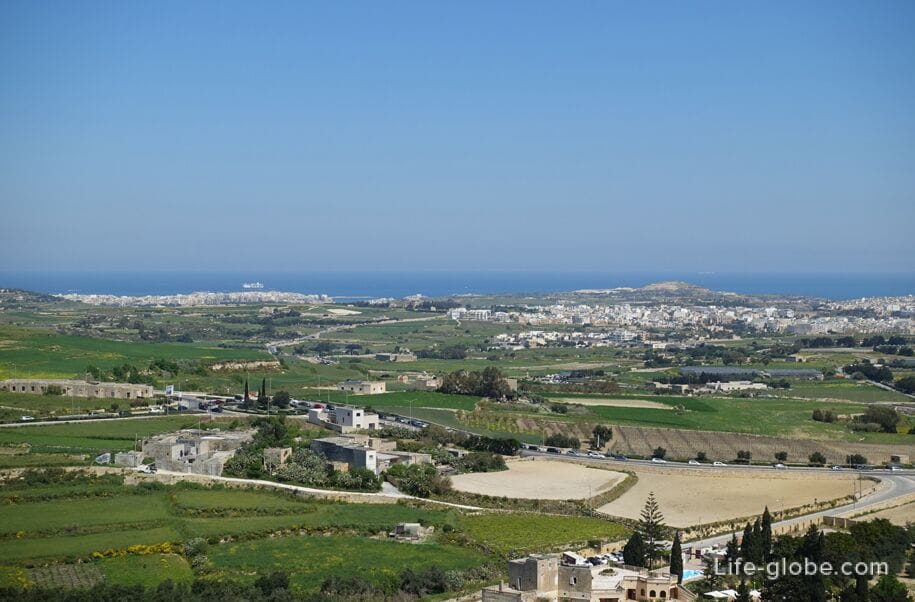

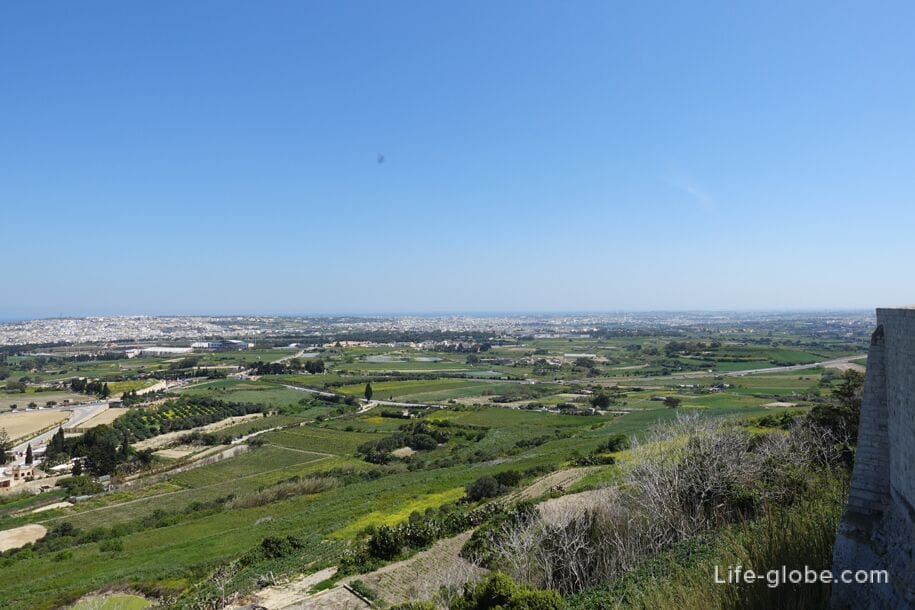

Photo of the square
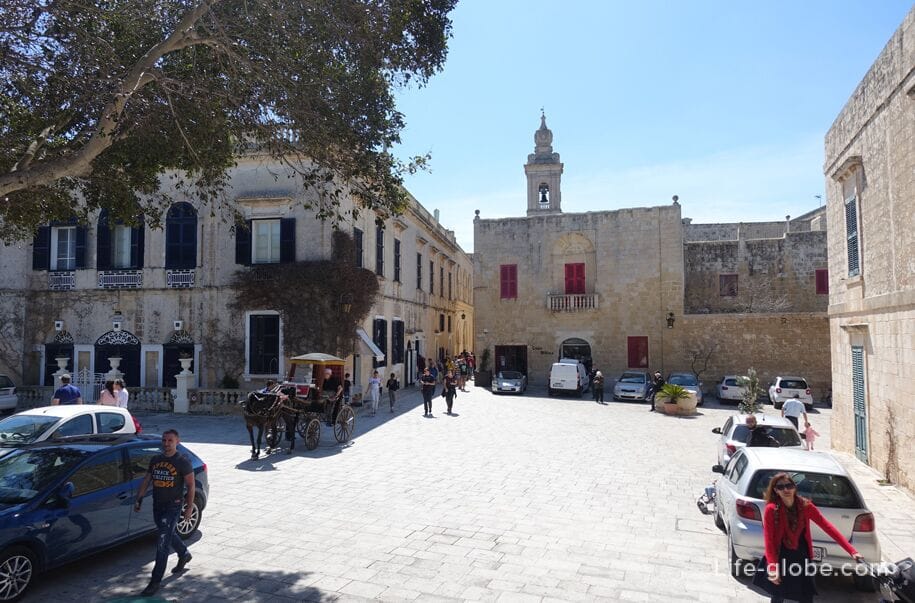
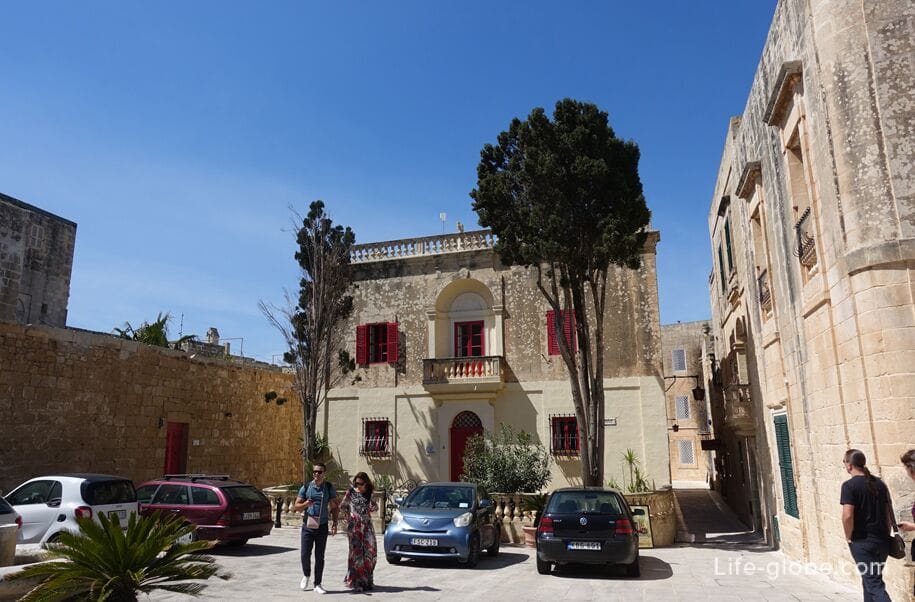
The Church and Monastery of St. Peter (Maltese name: Il-knisja u Monasteru ta' San Pietru), which was a Catholic Benedictine monastery, and the neighboring church is dedicated to Saints Peter and Benedict.
It is not known when the monastery was founded, but it is known that the first nuns arrived in Malta in the early 15th century. Thus, the monastery of St. Peter was founded around 1418. The current church, as it looks today, was restored around 1625 on the initiative of Bishop Baldassare Callares.
The altar of the church, dating from 1682, depicts the Madonna and Child with St. Peter, St. Benedict and St. Scholastica. The chapel also contains the remains of Blessed Maria Adeodata Pisani, a nun who lived in the monastery in the mid-19th century. Blessed Maria Adeodata was beatified by Pope John Paul II in 2001.
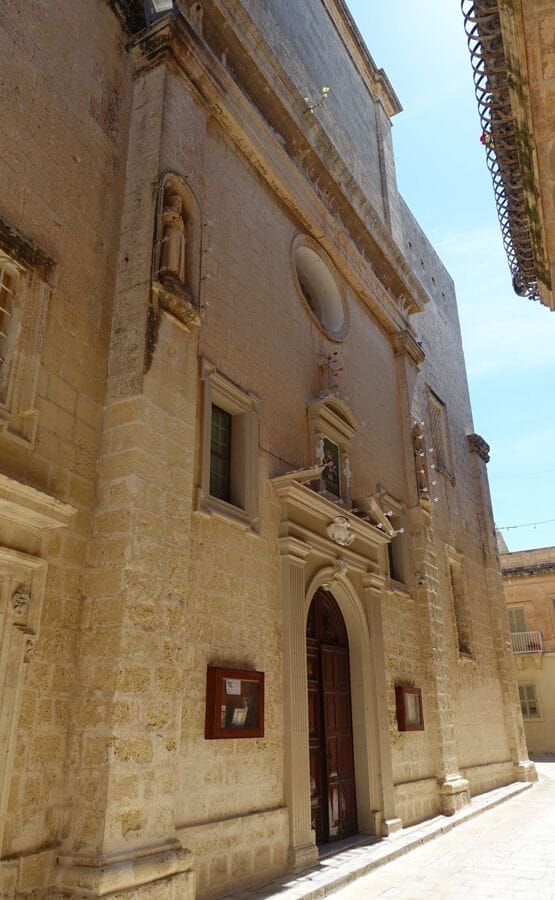

The Church of St. Peter in Chains, consisting of a nave with a ribbed vault dating from the end of the sixteenth century.
At the eastern end of the church there is a shallow niche for the altar, framed by high pilasters. The gable roof stands out from the outside. On the western facade, the pediment forms a cornice, above which there is a small bell tower. Above the doorway is a large enclosed circular oculus, surrounded on both sides by two empty squares, which were presumably intended to accommodate coat of arms shields or, possibly, commemorative inscriptions.
The church has been restored since 1956.

Mesquita Square, which attracts attention with an old well and which participated in the filming of the TV series "Game of Thrones", where one of the brothels of the Little Finger was located.
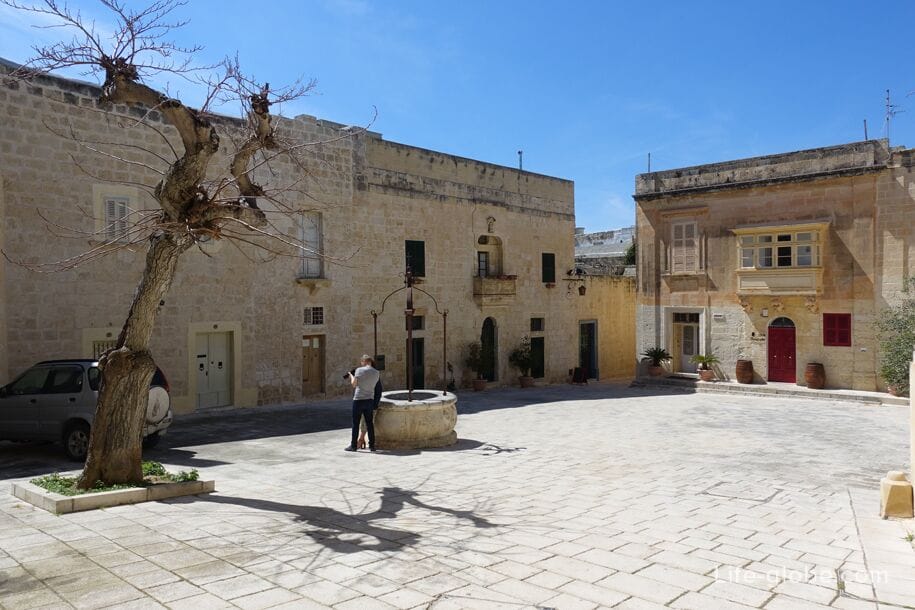
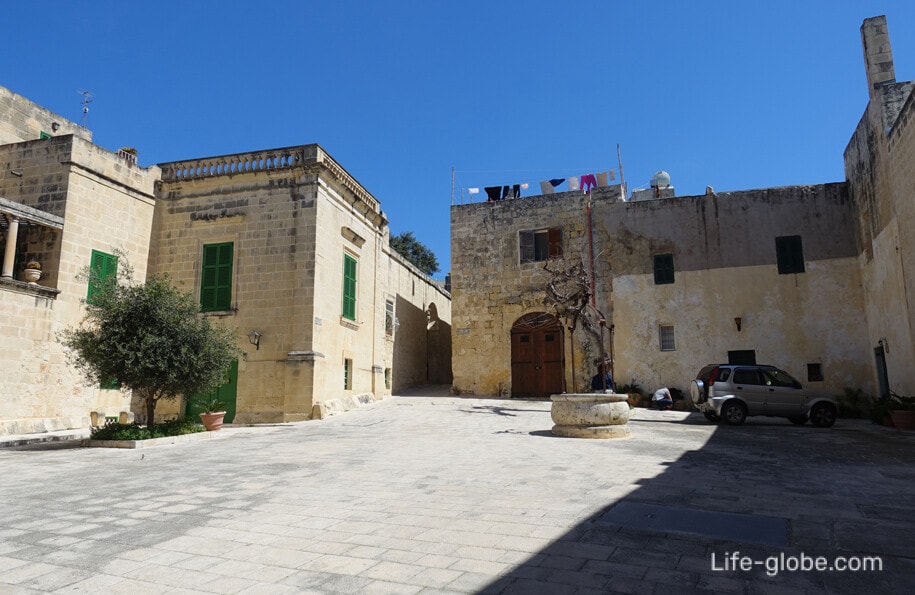

Outside the city walls of Mdina
On the south side, outside the city walls of Mdina, there is a small square, there are several monuments, public buses stop here and horse-drawn carriages are waiting for their passengers, in which you can ride through the streets of Mdina.
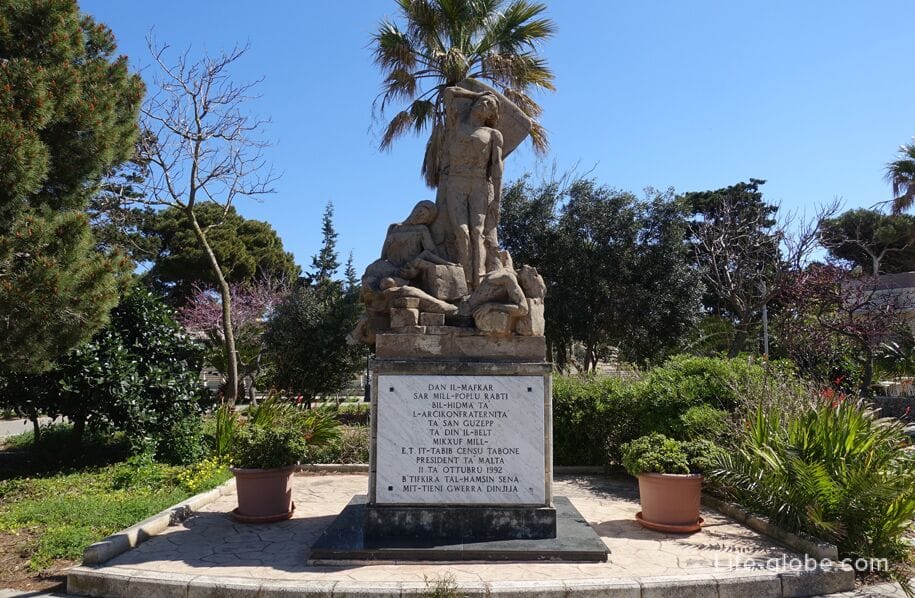


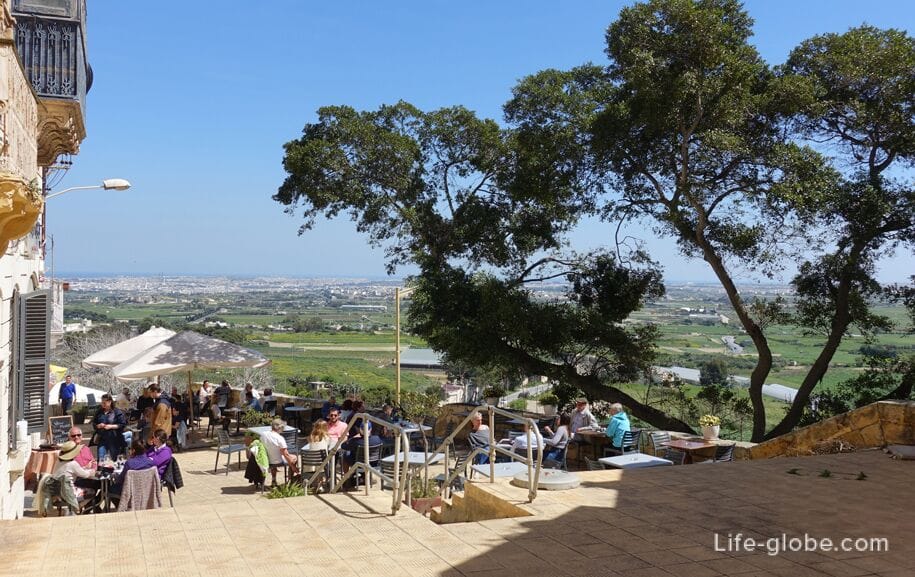
In the southeastern part of the outskirts of Mdina (the border with Rabat) is The Old Casino (Casino Notabile) is a small eclectic ornate building built around 1887-1888 by Webster Paulson.
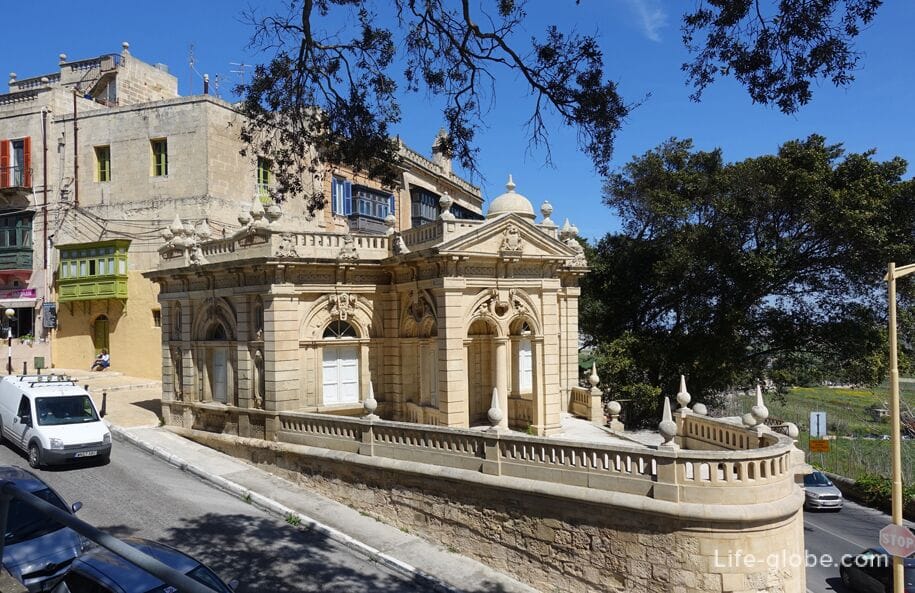
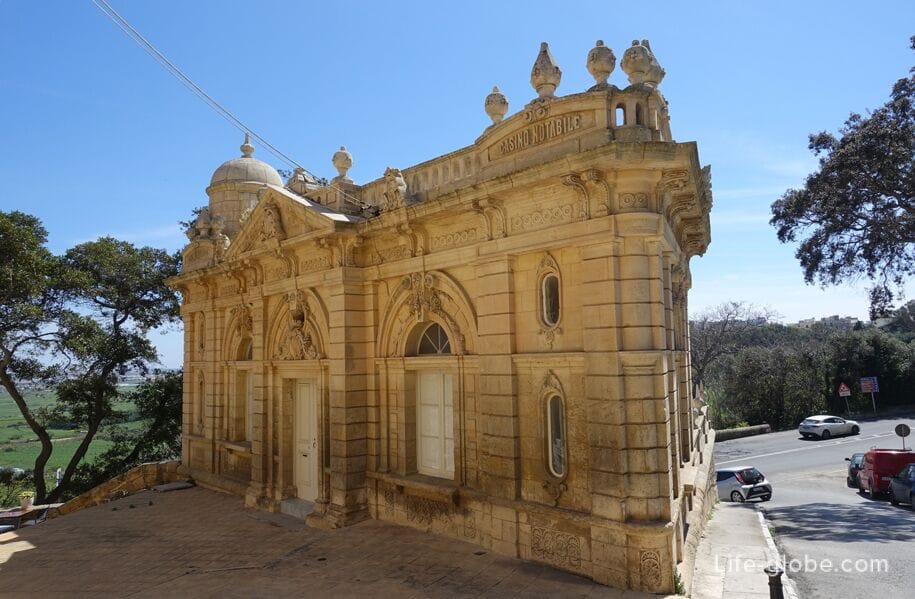
In the southwestern part of the outskirts of Mdina (the border with Rabat) there are some remains of a ruined Roman building (Domus Romana), built in the I century BC as an aristocratic mansion (domus) in the Roman city of Melite. In the 11th century, a Muslim cemetery was founded on the ruins of the house.
The site was discovered in 1881 with several well-preserved Roman mosaics, statues and other artifacts, as well as a number of tombstones and other cemetery remains. Since 1882, this place has been open to the public as a museum.
After the first excavations of the domus, a museum was built on the site of the peristyle of the house to preserve its mosaics.

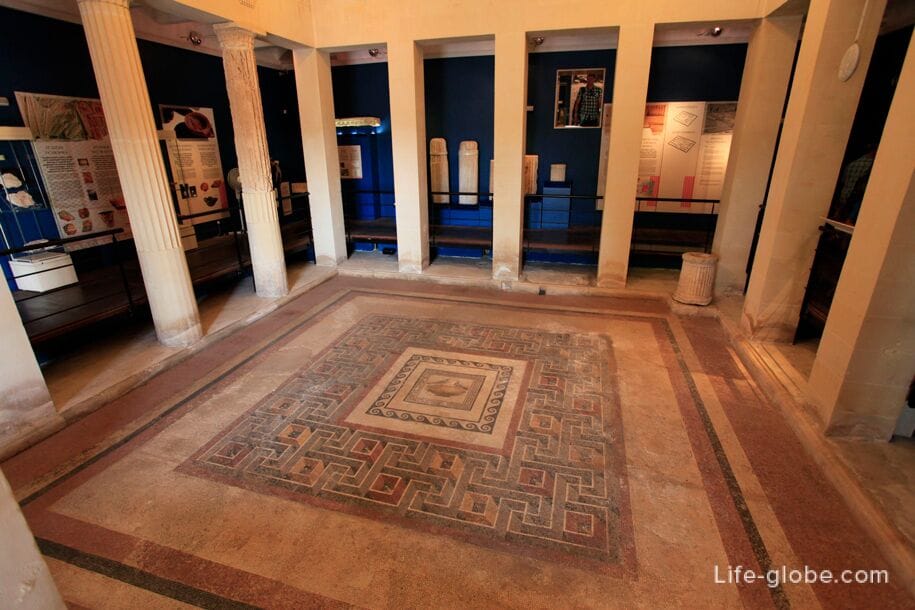
Rabat
From the south, Mdina is bordered by the city of Rabat (full name Ribat al-Fatah, Ir-Rabat), which houses historical monuments, churches and temples, museums, as well as the catacombs of St. Paul (St. Paul's Catacombs).
There are cafes and restaurants, shops and accommodation facilities (hotels, apartments) in the city
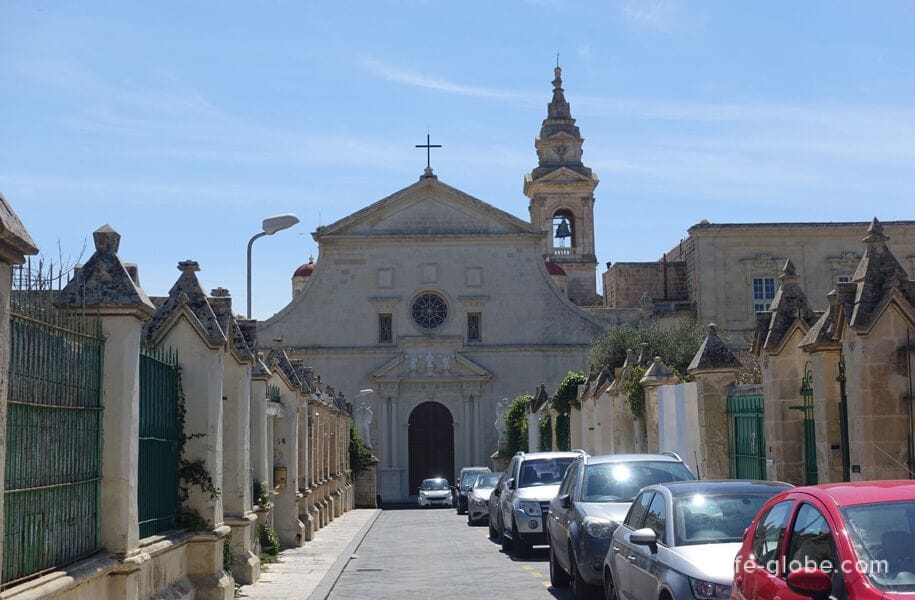
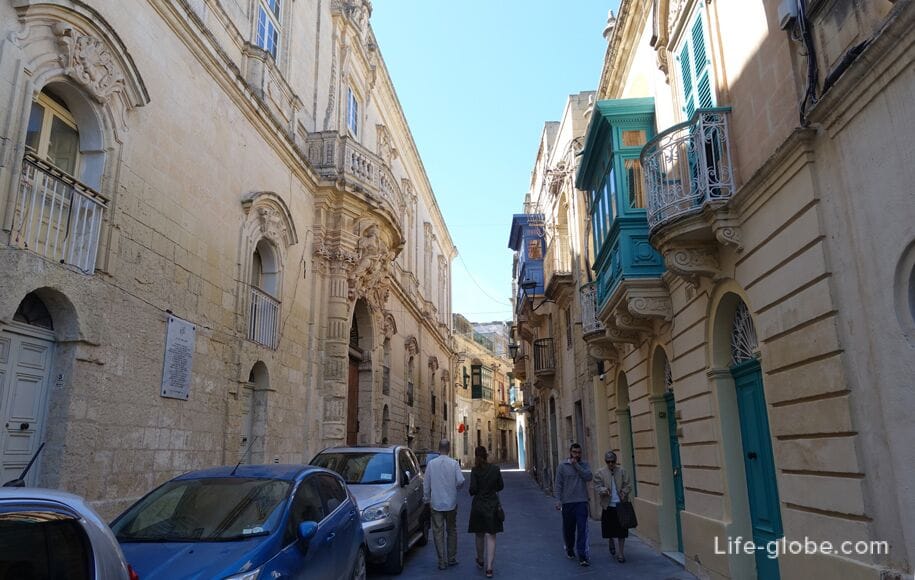

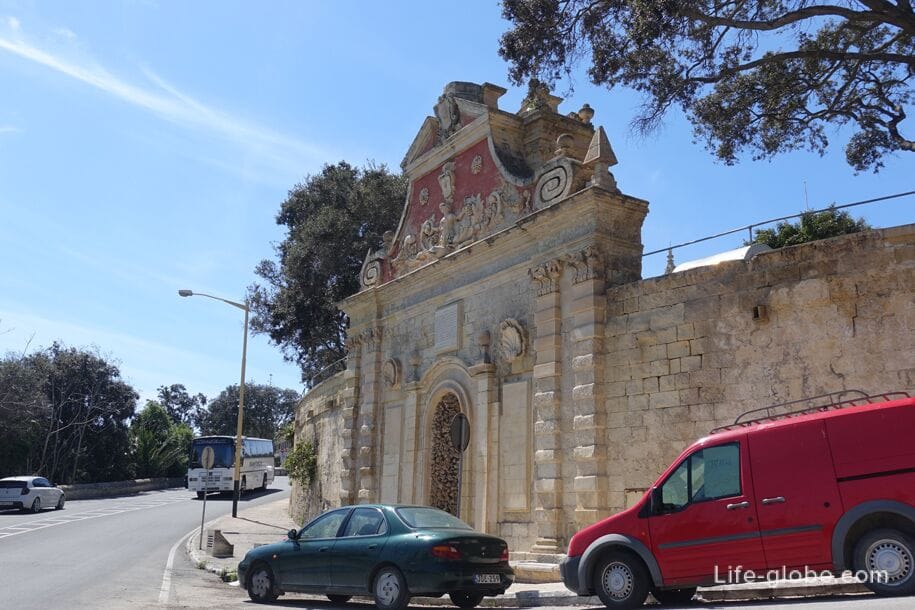

Practical information
Entrance to the city of Mdina (outside the city walls) is free.
Water to the museums of the city is paid.
Coordinates of Mdina: 35°53'09.0"N 14°24'11.0"E (35.885833, 14.403056).
Mdina on the map
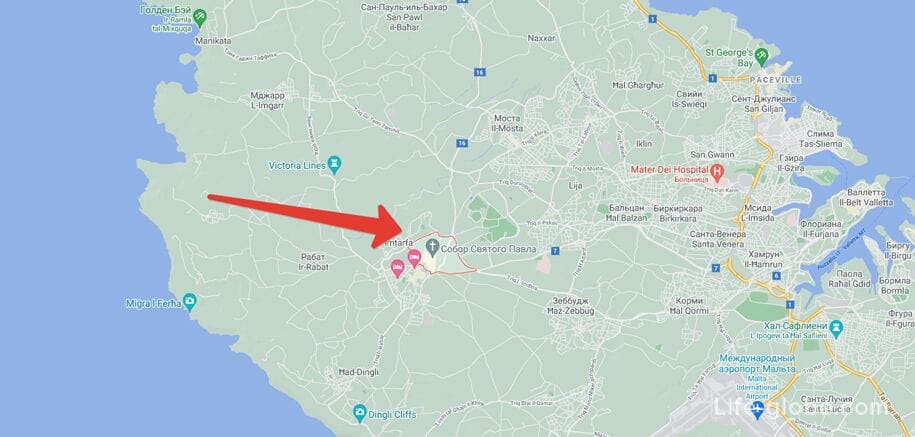
You can get to Mdina by taxi, rented car or public buses around Malta, including from Valletta and Slima. Malta public transport website: publictransport.
You can also visit Mdina on an excursion bus tour of Malta with an audio guide. All tours of Malta, including bus and sea, can be viewed and purchased here →
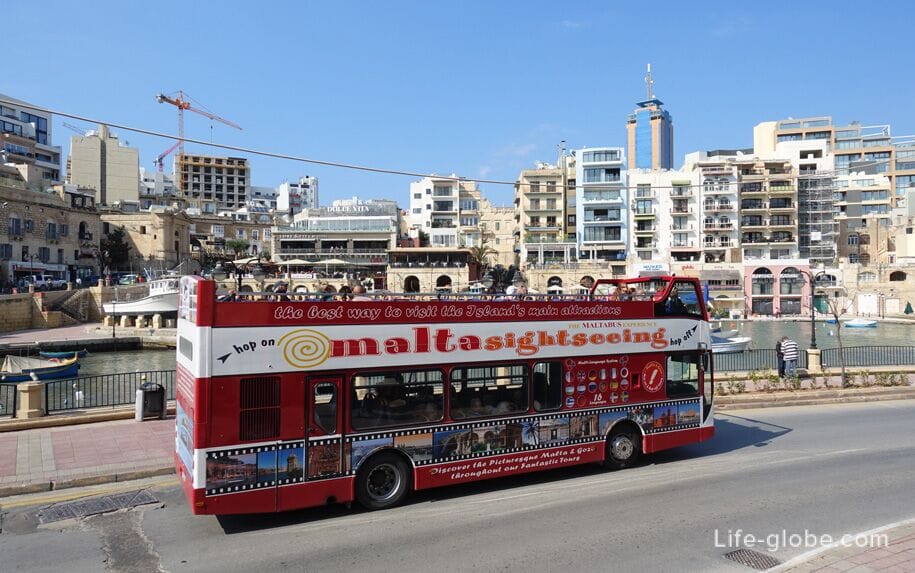
All accommodation facilities in Malta, including Mdina, Rabat, Valletta, Sliema, Mosta, Melliehi and other places, can be viewed and booked here




